-
Posts
2.332 -
Joined
-
Last visited
-
Days Won
60
Posts posted by Sundiata
-
-
4 hours ago, Nescio said:
I don't really like the faction emblem; the style seems to be too different from those of all existing civilization icons.
Hmmm, I'm probably biased, but I like it: Amun looking down on his subjects... It's different, but Kushites are different from the existing civilizations anyway... I don't see any real stylistic continuity in the other emblems either, apart from them being round, so I decided on one of the most commonly mentioned and depicted symbols of power: their state-god, the ram-headed Amun of Napata. It fits well with the obsessively theocratic nature of Kushite society. I'm always open for suggstions, but please nothing generic... Factions, including their emblems should be historical and unique, not hammered in to uniformity to fit with the other civs (that's how you get a bland game).
Anyway, any ideas on this more important issue:
4 hours ago, Sundiata said:The Skybox isn't working properly. At low angles, you can see the lower rim of the box above the horizon?? Very displeasing, from an aesthetic point of view. The Skybox should extend far below the horizon to avoid such weirdness..
The issue creates a very distracting and ugly black band along the horizon.... Extending the box far below the horizon, would make the horizon look like an actual horizon, and not a black hole resembling the end of the world. It's necessary to fix this in order to make marketable screenshots without having to "hide" the horizon behind structures...
-
13 hours ago, LordGood said:
I'm glad I didn't skimp out too much on polygons
So am I! They look amazing from all angles. Zooming around my little town on a low angle allowed me to catch some glimpses of those areas of your models which you wouldn't see in a standard game, and they look great, inside and out!
13 hours ago, LordGood said:those low angle shots look nice.
Thanks, but they could be a lot better. The Skybox isn't working properly. At low angles, you can see the lower rim of the box above the horizon?? Very displeasing, from an aesthetic point of view. The Skybox should extend far below the horizon to avoid such weirdness..
13 hours ago, LordGood said:lol I haven't even played as the Kushites yet in any capacity
Maybe you should, lol. Anyway, spending your time making so many pretty models instead of playing really isn't wasted...
-
This game is so pretty...
Some more Kushites, in Vox Populi:
And some more:
SpoilerCheck out: Vox Populi & The Kingdom of Kush, a proper introduction for more information.
-
 3
3
-
-
Making the farm building (dropsite for food) a pre-requisite for fields, and taking away the ability from the CC to function as a dropsite (or penalising the use of the CC by reduced efficiency) would automatically stop people from building fields right around their CC's. I think it would intuitively make people build farms and fields further away from the CC and in turn make them more vulnerable to raiding. More logical/realistic too.
Reducing the amount of workers per field, or increasing the size/footprint of a field (rectangular is much more logical/realistic) would also force people to build more of them, and/or spread them out more, which would create a healthier balance in terms of town/countryside.
That diminishing returns thing is very incognito indeed. I had no idea it was even implemented or how it works? Micromanaging resource gathering in general is pain in my opinion...
-
 2
2
-
-
@elexis Thanks! I guess it's related to my sometimes intermittent internet connection... Sometimes it's perfect, but other times it makes you want to bash your head against a wall. I'll try your sollution and get back to you when i play some more online games.
-
Kerma: Capital of the first Kingdom of Kush (c. 2500-1500 BC)
Aerial view of a historic reconstruction of the central district of the Royal City of Kerma, somewhere around c. 2000 - 1500 BC, showing the Western Deffufa, a massive mud-brick religious monument, still standing today at 18meters in height, surrounded by elite residential area's. This central area was walled with massive earthen ramparts with bastions. A large necropolis, shrines, palaces and agricultural villages extending north and south towards the fertile plain of the Nile surrounded this district.
Just to offer some historical context and explain the cultural substrate of Kush I want to share some images and a short introduction to the history of the first Kingdom of Kush, also known as the Kingdom of Kerma. Around 2500 BC The Kingdom of Kerma eveolved out of pre-Kerma and Kerma culture which started as early as 3500 BC, in northern Sudan. The history of Kerma illustrates that the later Kingdoms of Kush weren't just mere reflections of Pharaonic Egypt, but were built on an enduring millennia old legacy that actively shaped the history of Egypt itself.
I will simply quote some good sources on the subject here:
Kerma (also known as Dukki Gel) was the capital city of the Kerma Culture, which was located in present-day Sudan at least 5500 years ago. Kerma is one of the largest archaeological sites in ancient Nubia. It has produced decades of extensive excavations and research, including thousands of graves and tombs and the residential quarters of the main city surrounding the Western/Lower Deffufa.
Around 3000 BC, a cultural tradition began around Kerma. It was a large urban center that was built around a large adobe temple known as the Western Deffufa.[1]
As a capital city and location of royal burials, it sheds light on the complex social structure present in this society.
Settlement periods:
Pre-Kerma (c. 3500–2500 BC) No C-Group culture Phase
Early Kerma (c. 2500–2050 BC) C-Group Phase Ia–Ib
Middle Kerma (c. 2050–1750 BC) C-Group Phase Ib–IIa
Classic Kerma (c. 1750–1580 BC) C-Group Phase IIb–III
Final Kerma (c. 1580–1500 BC) C-Group Phase IIb–III
Late Kerma – ‘New Kingdom’ (c.1500–1100? BC) ‘New Kingdom’
By 1700 BC, Kerma was host to a population of at least 10,000 people.[5] Different to those of ancient Egypt in theme and composition, Kerma's artefacts are characterized by extensive amounts of blue faience, which the Kermans developed techniques to work with independently of Egypt,[6] and by their work with glazed quartzite and architectural inlays.
Kerma contains a cemetery with over 30,000 graves. The cemetery shows a general pattern of larger graves ringed by smaller ones, suggesting social stratification. The site includes at its southern boundary burial mounds, with four extending upwards of 90 metres (300 feet) in diameter. These are believed to be the graves of the city's final kings, some of which contain motifs and artwork reflecting Egyptian deities such as Horus.
For decades after Reisner’s excavations, his dismissal of the site as an Egyptian satellite fortified city was accepted. “The patient and diligent work of Bonnet and his colleagues unearthed the foundations of numerous houses, workshops, and palaces, proving that as early as 2000 BC Kerma was a large urban center, presumably the capital city and a burial ground of the kings of Kush”.[12] From 1977 to 2003, Bonnet and an international team of scholars excavated at Kerma.
In 2003, black granite statues of pharaohs of the Twenty-fifth Dynasty of Egypt were discovered near Kerma by Charles Bonnet and his archaeological team.
- Wikipedia: Kerma -
Kerma was evidently a sizable political entity - Egyptian records speak of its rich and populous agricultural regions. Unlike Egypt, Kerma seems to have been highly centralized. It controlled the 1st to 4th Cataracts, which meant its domain was as extensive as ancient Egypt.
Numerous village communities scattered alongside fields of crops made up the bulk of the realm, but there also seems to have been districts wherein pastoralism (goat, sheep and cattle) and gold processing were important industries.[6] Certain Kerma towns served to centralize agricultural products and direct trade. Analysis of the skulls of thousands of cattle interred in royal Kerma tombs suggest that stock were sometimes brought vast distances, from far districts, presumably as a type of tribute from rural communities on the death of Kerma's monarchs. This parallels the importance of cattle as royal property in other parts of Africa at later times.
Only the centres of Kerma and Sai seem to have had contained sizable urban populations. Possibly further excavations will reveal other regional centres. At Kerma and Sai, there is much evidence of wealthy elites, and a class of dignitaries who monitored trade in merchandise arriving from far-off lands, and who supervised shipments dispatched from administrative buildings. Evidently, Kerma played an important intermediary role in the trade of luxury items from the Central African interior to Egypt.
During the First Intermediate Period, the Egyptian presence in Lower Nubia ceased. When at the beginning of the New Kingdom, Egyptian sources again mentioned the region of Kerma, they reported Kerma as being in control of both Upper and Lower Nubia.
The long history of Egyptian military activity in Lower Nubia may indicate that Kerma was perceived as a threat to Pharaonic Egypt at varying times. Principal Egyptian fortifications were built in the middle Nile Valley during the Middle Kingdom.[8] These were to secure the Upper Egyptian border against raids from Kerma, and more than likely and to protect the valuable trade routes between the two regions.[3] Both during the Middle and New Kingdoms, the resources Kerma possessed – gold, cattle, milk products, ebony, incense, ivory, etc. – were much coveted by Egypt. Its army were built around archers.[9]
During its zenith, Kerma formed a partnership with the Hyksos and tried to crush Egypt. Discoveries in 2003 at the Governor of El Kab's Tomb (near Thebes) show that Kerma invaded deep into Egypt between 1575 and 1550 BCE. It is believed that this was one of Egypt's most humiliating defeats, which later pharaohs had erased from the official historic records. Many royal statues and monuments were looted from Egypt and removed to Kerma, apparently as a gesture of triumph by Kerma's ruler.[10]
Under Tuthmosis I [and Ahmose I], Egypt made several campaigns south.[11] This eventually resulted in their annexation of Nubia (Kerma/ Kush) c.1504 BC. After the conquest, Kerma culture was increasingly 'Egyptianized' yet rebellions continued for 220 years (till c.1300 BC). During the New Kingdom, Kerma/Kush nevertheless became a key province of the Egyptian Empire - economically, politically and spiritually. Indeed, major Pharonic ceremonies were held at Jebel Barkal near Napata,[12] and the royal lineages of the two regions seem to have intermarried.
An inglorious end:
And finally, a decent summery on the history of Kerma
SpoilerThe Kushite kingdom traces its roots to the city of Kerma. While the start of civilization in Kerma may be traced back to the fourth millennium BC, the kingdom is thought to have sprang in approximately 2600 BC. The wealth of the kingdom is reflected in the archeology, particularly the burial findings of the royalty. Gold, ivory, and various types of jewelry attest to an expanded trade network that connected Kerma to the sub-Sahara in the south, the Red Sea coasts in the east, and the Mediterranean world towards the North.
Kerma is known among archeologists for the unique architecture of its metropolis, which reflects an exceptionally high degree of urban organization. The city had its own expanded harbor quarter facing the Nile, thick fortification walls and bastions, royal residence and cemeteries, religious buildings, storehouses, and bakeries.1
Moreover, the archeology of the city indicates that the political structure of the kingdom was more complex than the monocratic political system of ancient Egypt. Authority and power in Kerma were distributed over an expanded class of elites, which encompassed royal dignitaries, wealthy merchants, and high officials and administrators. The archeology of the cemeteries indicates that it wasn't just the rulers that had splendid burials.
Because of this, the political structure at Kerma seems to have anticipated the government system of Kush of the Napatan-Meroeitic period. During the latter period, the political authority of the kingdom was distributed between the priesthood, the king, royal dignitaries, and the military.
One problem that faces archeologists and historians in studying Kerma is the lack of surviving written documents. This is due to two possible reasons: (1) Perishable mediums, such as wood and mud, which form common types of building materials in Kerma, did not allow the survival of paint-based writings and/or carved inscriptions; or (2) the destruction activities that took place during the Egyptian invasion of the city in the sixteenth century BC.
Fortunately, some archeological evidence and external written sources provide important indications on the development and expansion of the Kushite kingdom at Kerma. The Old Kingdom inscription of Harkhuf,2 suggests that the Egyptian pharaohs were worried about the ambitions of the Kushite kings in controlling Lower Nubia. Geographically, Lower Nubia has represented a buffer zone separating Egypt and Kush. Although the northern area of Lower Nubia was often Egyptian territory, its local population tended to ally with the Kushites.3
During the First Intermediate Period, when Egypt's power was waning, the Nubian C-Group population in Lower Nubia seems to have enjoyed a considerably high level of freedom. While the economy of Egypt was declining, archeological data from Lower Nubia suggest that the C-Group were politically indipendent.4
Historically, the Kushites have used their power of influence over Lower Nubia to intice rebellions within Egypt. Consequently, Egyptian controlled Lower Nubia exposed Egypt to Kushite colonial ambitions. Hence, the political independence achieved by the Lower Nubians during the First Intermediate Period is attributed to support from Kush.
This suggestion corroborates the account of Harkhuf, in which Lower Nubia is indicated as being absorbed by a larger state in Sudan.5
The Hyksos invasion of Lower Egypt, around 1786 BC, was a golden opportunity for the Kushites to expand northward. In 1650 BC, Kush made alliance with the Hyksos. While the Hyksos ruled Lower Egypt, the Kushites controlled Upper Egypt. The authority of independent Egyptian kings was consequently limited to a small area around Thebes.6 The population of Upper Egypt, on the other hand, seems to have accepted the domination of Kush without resistance. This is best indicated by lack of any evidence for rebellions in the region.
After the Egyptian pharaoh Ahmose defeated the Hyksos in 1550 BC, he turned his attention to Kush. Ahmose had to defeat Kush in order for him to ensure control over Upper Egypt. The war with the Kushites lasted for fifty years, with wins and losses on both sides.
Persistent invasions of nomadic groups in the peripheries of Kerma weakened the Kushite kingdom. By 1500 BC, the Kushites were overwhelmed and were defeated by the invading Egyptian armies. Although Kerma was sacked in 1500 BC, the fate of the Kushite kingdom remains the subject of ongoing controversy among scholars today.
- The Kushite Kingdom at Kerma -
More images of ancient Kerma:
SpoilerSite plan of the excavated area's of the ancient city of Kerma
Another model of the Royal City around the time of it's zenith. Established around 2500 BC, this is the earliest known urban complex in Black Africa. The ancestral site of the later Kingdoms of Kush, who kept this place in reverence, evidenced by the continued use of the necropolis for royal burials many centuries after the demise of the old city..
An artists' rendition of Kerma which I already shared in the first post of this thread.
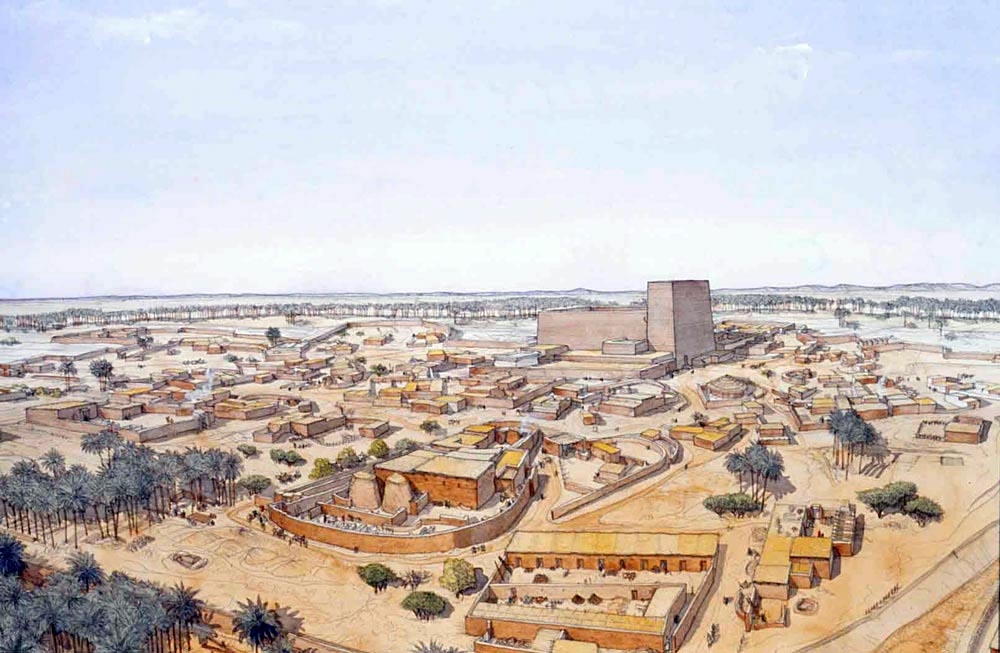
One of the proposed renditions of the Western Deffufa. If indeed the facade featured these two separate "towers" (which seems probable), it would mean this is the oldest surviving (proto-)pylon temple in the world. An indication of Kerma's influence on the development of ancient Egyptian religious customs, including architecture. It also explains the popularity of pylon temples in the later Kingdoms of Kush. Vaulted chambers also seem to be a very early development.
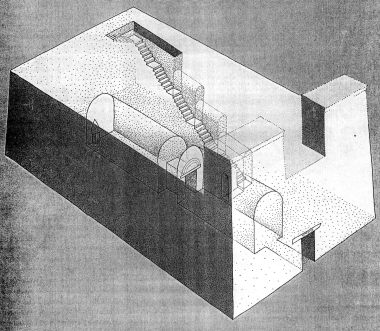
Facade of the Western Deffufa today
side view of the Western Deffufa
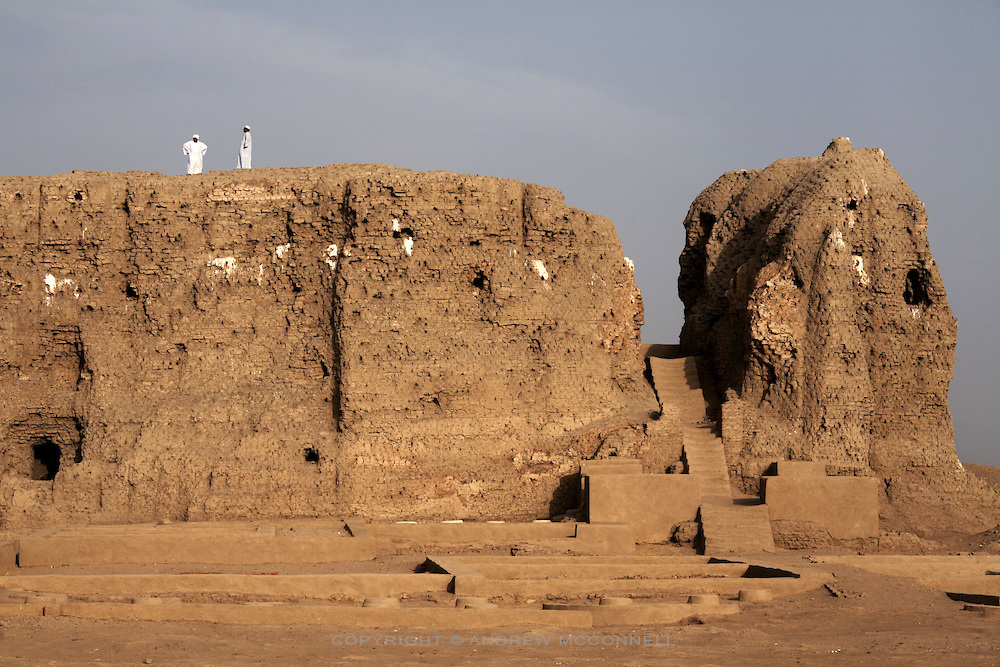
Other side view of the Western Deffufa
Aerial shot of the central archaeological site of Kerma
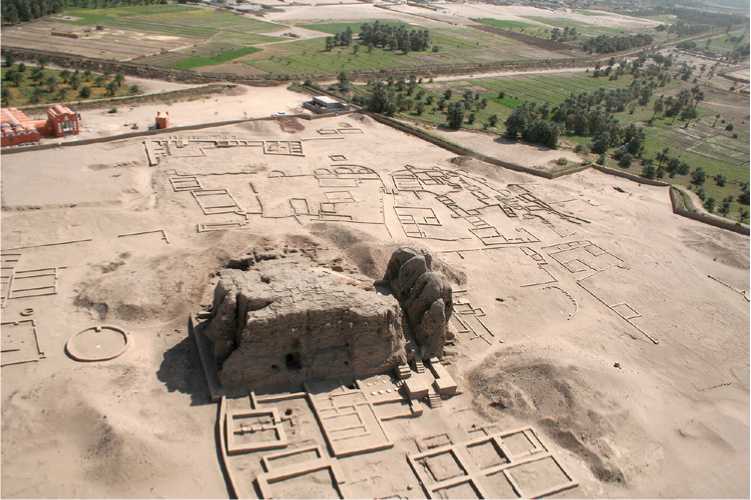
Royal funeral in ancient Kerma. Cattle was sacrificed on a grand scale (sometimes many thousands of cows for a single grave), and the practice of human sacrifice has been postulated.
Kushite siege of the massive Middle Kingdom Egyptian fortress of Buhen in the Kerma-period. All of the Middle Kingdom fortresses in Lower Nubia were eventually conquered by the same Kushite invaders they were designed to halt.
Finally, one of the products Kerma was famous for: Faience. A Kerma period Kushite is seen wearing a skullcap/helmet with chinstrap.
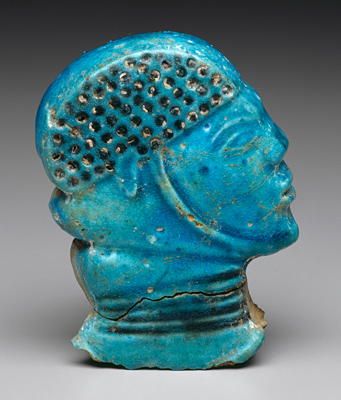
-
 1
1
-
 2
2
-
-
-
1 hour ago, elexis said:
Last time I checked its about 1 in 10 persons that can't connect to every game in the lobby.
Are you sure? I have this UDP port issue or that STUN endpoint-thing almost every time I go in the lobby and try to connect. It usually eventually starts working by repeatedly trying to join a game, but sometimes there's no point in trying. I've had friends experience the same thing almost systematically. It kind of spoils the fun, If you're not computer-savy and just want to play a game. Makes you give up trying, especially seen as it seems to be totally random/unpredictable...
-
5 hours ago, LordGood said:
"cow dinosaur"
Tyrannotaurus, Tauropods, Bovid-Rex, Bos Taurusaurus, Bos Giraffidae-Rex, Camelopardalisaurus...
I'm going to be quiet now.
-
 1
1
-
 1
1
-
-
The Kingdom of Kush: The final great reference dump for Kushite Reliefs
This post is essentially a photographic addendum to Voyage à Meroë and The Lepsius Collection. As with the other two, this collection is quite extensive, and the three sources combined form a great basis for comparative studies of Kushite reliefs.
Some of the conclusions we can draw from these reliefs relate to the enduring and evolving nature of Pharaonic culture and religion, well in to the Christian period. In every sense, these people considered themselves the true heirs of the New Kingdom. There is an almost dogmatic adherence to "Egyptian" styles, but for those paying close attention, there are many peculiarities typical of Kushite art.
Some of the more interesting details in a number of these reliefs regard the ethnicity of the subjects, which is more clear in these photographs, than they are from the early 19th century sketches by European explorers. Kushites looked just like modern Nubians (Nilo-Saharans) in lower Nubia, and like Nuba and South Sudanese (also Nilo-Saharan) in Upper Nubia. Both ancestral groups mixed extensively with each other, and to a certain degree with Afro-Asiatic speakers (Ancient Egyptians and nomadic peoples like the Beja or Afar).
Another interesting point is the large variation in quality of the reliefs. Some are very crude, while others represent some of the finest reliefs ever produced in the Nile Valley, not only rivalling their Egyptian predecessors, but surpassing them. High quality reliefs were produced throughout the Napatan and Meroitic periods, but most have been thoroughly destroyed since. We only poses a fraction of what would have once been a massive corpus.
The few weapons and armours depicted confirm what we already established earlier: Bow and Arrows, Spears, Pikes, Swords, Axes, Mace-Axes, Oval Shields, Skullcaps, Cotton Corselets and Bronze Scale Armour Corselet.
The Reliefs of Kush:
SpoilerI will begin by first sharing some more drawn copies of reliefs for which no photographs have been published:
Reliefs from the lower podium of temple M250, at Meroë, sometimes called the sun temple, 1st century BC. This piece is extremely interesting as it actually depicts the building it was carved unto, with an outer pylon, an inner pylon and colonnades. A seated ruler is seen in front of a typical kiosk, as his cavalry and infantry accompany him behind the kiosk.
Oval shields, spears and pikes from temple M250
Sword, pike and spears.
Spears, pike, axe and sword
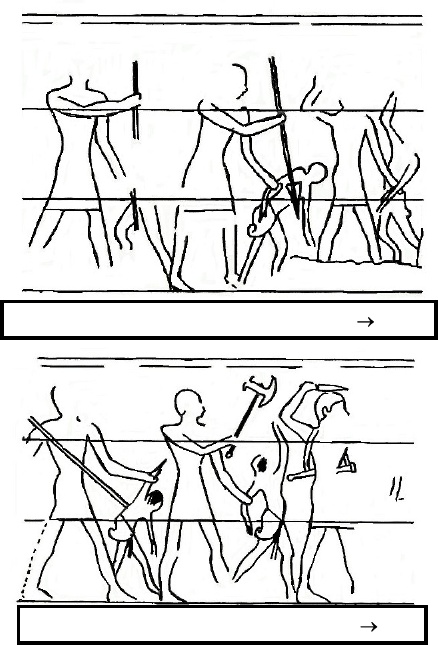
A fierce looking Meroitic royal, with scarifications on his cheeks, a common practice among Meroites, and still practiced across Africa. Essentially a tribal mark.
Relief in wood, showing a lion in front of a ruler seated on an elephant with a blanket covering it's back. This is from Meroe, another hint at the importance of elephants to the rulers of Kush.
Victory relief of the Meroitic King Sherkarer, or Shorkaror. He is carrying a sword, still in it's scabbard, swung around his back, a spear and bow and arrow. He's receiving blessings in the form of Sorghum and prisoners from a solar deity peculiar in its artistic style. This is actually Mithras, a Romanised form of the Persian God Mithra, being worshipped by a Meroitic Royal in the southern reaches of the Kushite Empire. Talk about cross-cultural influences... Jebel Qeili, 1st century AD.
Photographic collection of Reliefs:
Taharqa
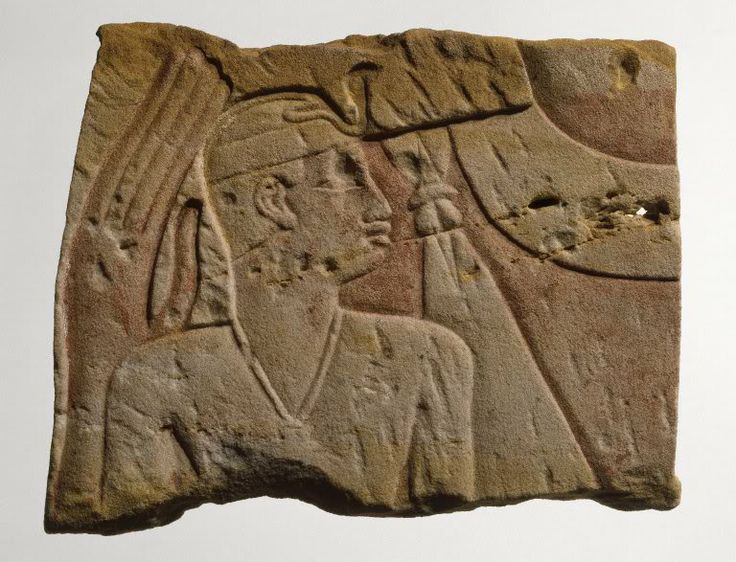
Black Isis, from Naqa
King Amanakhareqerema, from the pylon of temple 200, Naqa
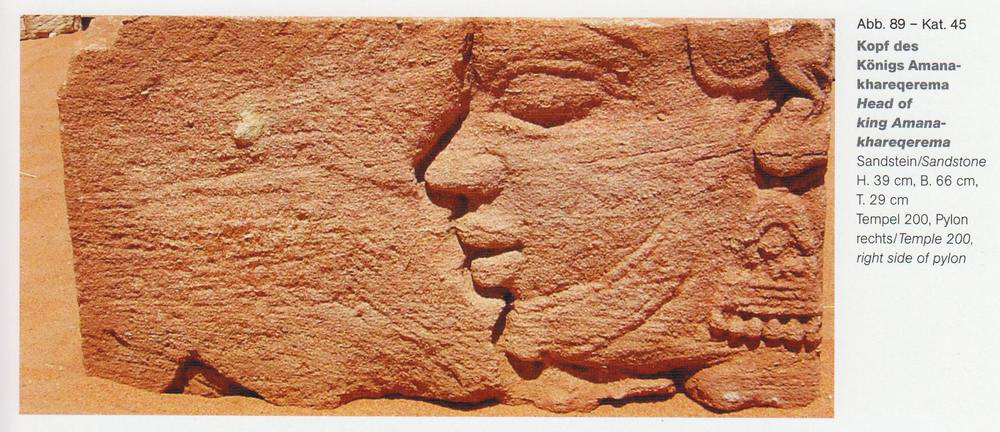
A Kushite ruler or deity, with an elaborate variation of the double crown
Kushite female royal, from Meroë
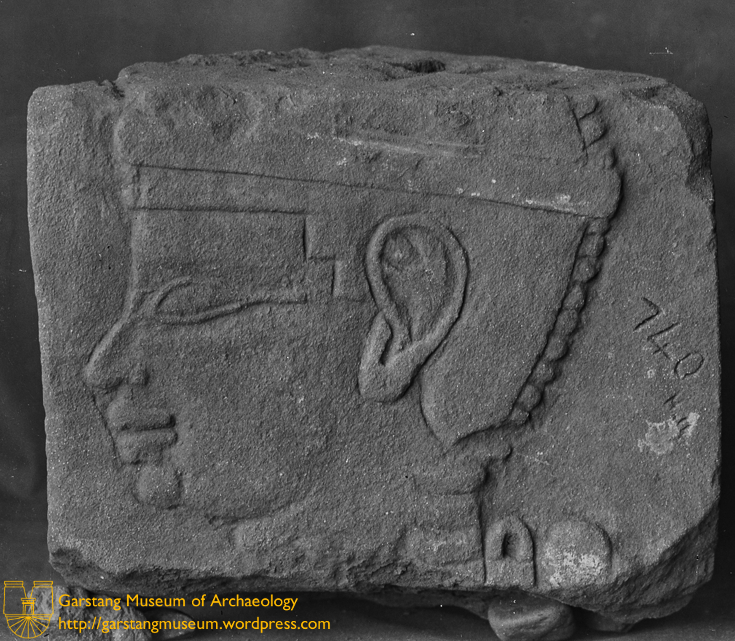
Meroitic Queen
Meroitic Queen
Meroitic King with the Double Crown and a Queen wearing the Hathor Crown (a pair of cow horns, sundisk and rearing cobra)
An very fine depiction of the Meroitic King, Arnekhamani wearing an elaborately decorated, horned skullcap and typical royal attire.
King with an elaborate crown, similar to the White crown of Upper Egypt, actually first attested in pre-dynastic Kush.
Another variation of the White Crown on a ruler wearing a very finely carved royal cloak, draped over one soldier, typical for Kushite Kings and Queens
Another Kushite ruler with the popular White Crown
Kushite ruler in an embrace with the human form of Amun, both wearing helmet-crowns with chinstrap. Amun is wearing scale armour.
King Natakamani and Queen Amanitore in front of a procession of the Gods: Apedemak, Ra-Horakhty (or Horus), Amun, Osiris and Khnum, an earlier Ram-headed God. From the Lion temple of Apedemak in Naqa
King Arnekhamani in front of a procession of the gods, Apedemak, Amun, Sebiumeker (?), Arensnuphis, Horus and a sixth, unidentified god, on the Lion temple of Apedemak in Musawwarat es Sufra.
A close up, to help appreciate the size of these reliefs.
King Arnekhamani, in royal attire, receiving a lily with an effigy of the God Apedemak, from the god Apedemak (these people have a sense of humour). He also gets some bound prisoners with the lily. A young prince, depicted significantly smaller than the god and the king, praises Apedemak.
Another close-up, to help understand the scale. Only the bound prisoner is life-sized, the other reliefs are super-sized. A strong psychological message.
Pylon of the Apedemak temple in Naqa, featuring King Natakamani and Queen Amanitore
Close up of Natakamani
Close up of Amanitore
Close up of the side of the pylon, with a serpent form of Apedemak
A closer close-up of Natakamani. He wears a very elaborate loincloth. His lion happily mauls someone's face, and some unlucky rebels are about to be smote.
Some relief fragments from Meroë. The lower block clearly depicts 2 archers, each with 2 feathers in their hair. A clear illustration of the use of feathers as an archery distinction in the Meroitic period.
Broken slabs from a Meroitic stone coffin bench
Broken slabs from a Meroitic stone coffin bench, depicting Anubis and Horus
The boat stand of King Atlanersa, showing the king with Horus and Thoth.
King Atlanersa
Detail on the boat stand of King Atlanersa
Detail on the boat stand of King Atlanersa
Meroitic Noblewoman. The top right corner show some kind of standard bearers, wearing capes
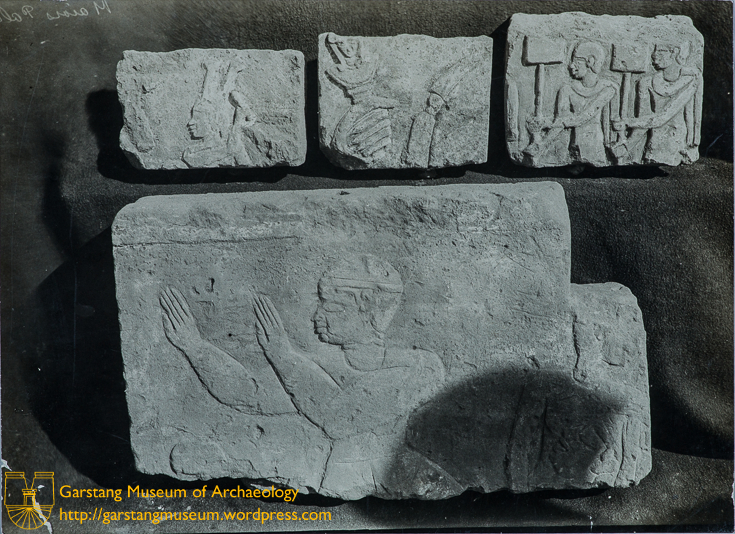
Partial remains of a once majestic relief of Apedemak inside the lion temple in Naqa. He wears a scale armour corselet.
Long horned cattle on a pyramid chapel in Meroë. These cows were an important source of wealth for Kush.
Elaborate pyramid chapel reliefs
Pyramid chapel reliefs in Meroë depicting Kushite nobles.
Pyramid chapel relief in Meroë depicting a seated ruler receiving some incense.
Procession of a funerary barge on a pyramid chapel in Merë
Pyramids and reliefs in Meroë
Royal scene on a pyramid chapel wall from Meroë. Everybody but the bound prisoners placed underneath the paws of the lion-throne have gentle smiles.
Meroitic nobles wearing common ankle-lenght garments
More ankle length garments
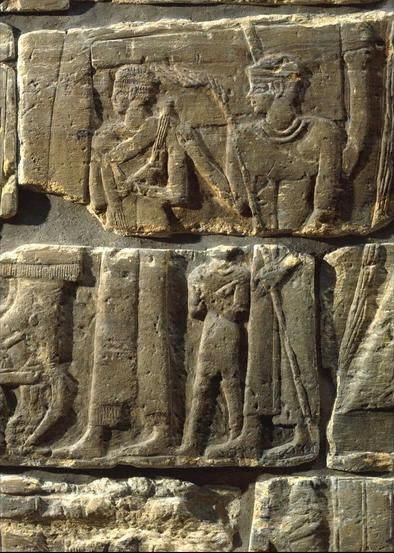
(pre-)Sarcophagus of a deceased royal, resting on a lion bench.
A King of Kush, and his Queen.
A loyal dog sits underneath the throne of a ruler, guarding bound prisoners as a winged Isis pour libation.
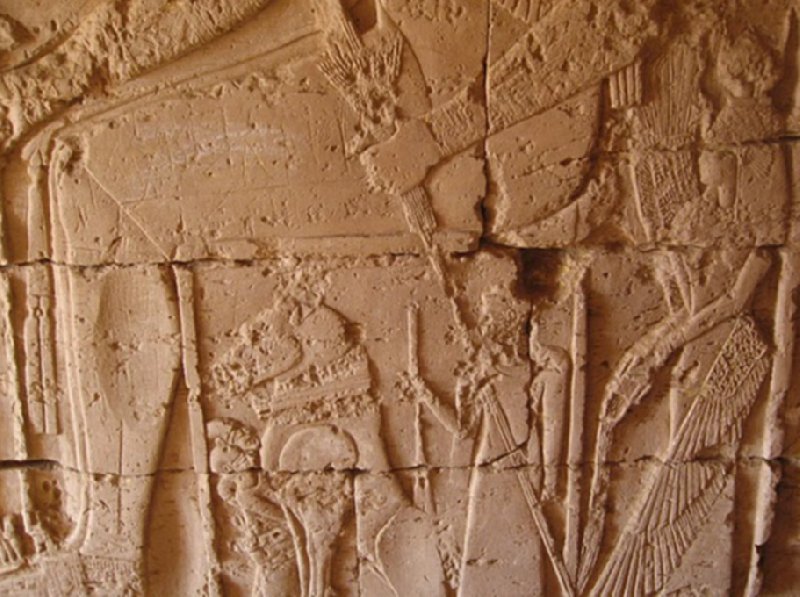
Detail of the libation pouring.
Meroitic King and Queen in front of the human form of Amun
Meroitic royals.
Three different ways of depicting a royal in Kush
Kushites' favourite subject, bound captives. From Meroë
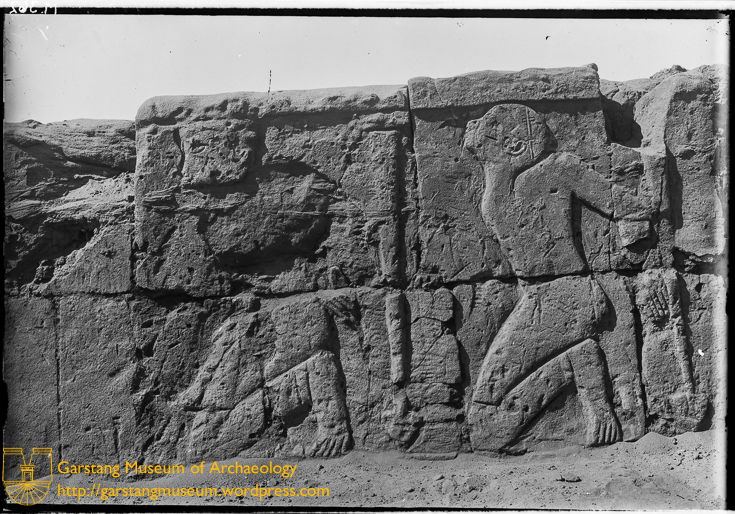
More bound captives.
Reliefs inside the lion of Apedemak in Musawwarat, depcting nobles.
A procession of cattle.
Close-up of the bull.
A proud looking horse, being led on a rope by a handler.
Difficult to make out, but this scene depict two horsemen. The left one caries a spear/lance with a strip of cloth around, and wears a cape and skullcap.
Top of a pylon decoration
Inside the rock-cut part of the temple of Mut, Gebel Barkal, Napata
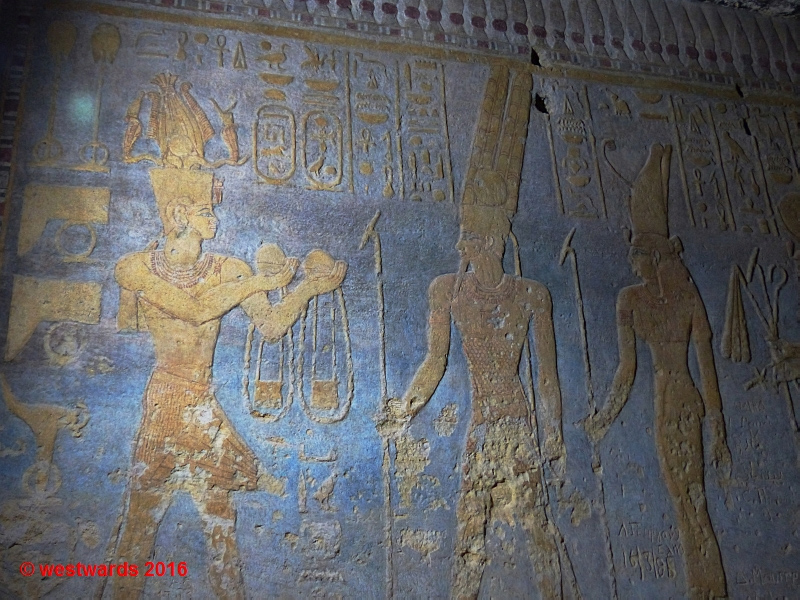
A possible example of a colour scheme for the reliefs
A very human depiction of the god Bes, from a supporting pilar of one of the temples at Gebel Barkal
Meroë pyramid chapel relief
The elephants of Musawwarat, with a ruler standing on their backs with a foot each
-
 3
3
-
 1
1
-
-
@serveurix I actually made a collage of species of flowers native to Great Britain
 :
:
The "problem" isn't so much that they look exotic, because they just look like generic flowers from anywhere in the world, but there's differently coloured flowers growing through each other. Just imagine a few species of pretty wild flowers growing in the same spot, and "problem" solved.
7 hours ago, LordGood said:you might just be weirded out by the two story Briton building
Might have more to do with it...
8 hours ago, Nescio said:- correct me if I'm wrong, but increasing the footprint also makes the structure more vulnerable to attacks, right?
- “half the size of a farm” would certainly not be anyway close enough to provide enough grass to feed even a single horse; better omit meadows than making them an unnecessary and unrealistic addition compromising reality;
- the courtyard of the proposed visual actor already has a fence.
I actually like the current design(s).
1) Stables should be more vulnerable to attack. They're large open spaces with a few structures, difficult to defend in real life. The structure could even be surrounded by smaller fenced areas all the way around it's sides and back, to represent this.
2) A fenced area half the size of a farm" is definitely enough room for a horse to stretch it's legs, which it needs to do at least once a day. In stables, food is delivered in the from bales of hay (good idea for a prop), not necessarily from meadows. This is how horses are kept in densely populated areas. Reality is continually compromised in the game. It's not a simulation, so all the models are just approximations anyway.
3) Indeed, but that's for combat practice. Horses need leisure time too

At the end of the day, it really doesn't matter, just an idea. I've been thinking about a lot of ways to break AoEII conventions, and visually it can be achieved by more unique models. For example, 0AD simply copied the "square farm" concept from AoE, but what is it's benefit, other than making everybody think the game is an age of empires clone. Vast majority of farms anywhere in the world are sort of rectangular, so why not make farms rectangular, in stead of square. Looks more realistic, and people will be less inclined to think it"s an AoE ripoff. Same goes for stables. Add a fenced area for a horse to actually walk around, and WHAM! Totally different from Age of Empires!
 And don't forget recognisability...
And don't forget recognisability...
-
Just a thought, but perhaps the footprint of the stables can be increased with a miniature fenced field (half the size of a farm) with an idle horse pacing around, directly adjacent to the building, to represent these "meadows". Would also make the stables 100% recognisable in an instant, even when zoomed out. It also makes it look more unique and realistic than the AoE equivalent.
I actually like the brightly coloured flowers and other vegetation.
-
I love this! It does so much to bring the siege-engines alive... With the new siege-workshops and other new structures the next alpha will be amazing, if everything is implemented of course.
-
 1
1
-
-
55 minutes ago, Nescio said:
Completely true. However, they peaked around c.700 BC, when they controlled Egypt, therefore I listed them under Archaic period.
Well they also peaked in the (second phase) Napatan period and the Meroitic Period, which is actually the time-frame I'm researching, when they were expanding more towards the South and simultaneously often maintaining a presence in South Egypt. Unless there were direct parallels to later Napatan and Meroitic periods, no 25th dynasty sources have been used for any of the models. My research focuses entirely on Sudanese sources, and I've been purposefully filtering out anything that might be Egyptian unless I specifically specified that it was Egyptian. The conclusion is abundantly clear: The Kingdom of Kush was a major power to be reckoned with, for a thousand years after their "loss" of Egypt. Even after their ejection from Egypt, they continued to shape and reshape the South-Egyptian political and religious scene. They actually continued ruling as Pharaohs of the two lands, although their effective control wouldn't have passed the Thebaid again after the 25th dynasty.
55 minutes ago, Nescio said:Things would be a lot easier if there were only three factions
I very seriously wouldn't play 0AD if it only had 3 factions. I straight up wouldn't even give it a chance... It's not 1995 anymore. 12 factions really aren't a lot according to today's conventions. Less civs really isn't better. Just a lot more boring... Balance wise, there is no reason two civs can't be very similar to each other, and it's especially not a problem when you have many civs. So you could have 20 civs, but balance wise, it feels more like 5 civs, with smaller historical differences between them. Best of both worlds...
-
 1
1
-
-
Ok, we're starting to find more common-ground

Isn't a lot of Imperial Rome already in Delenda Est? What work would need to be done?
one correction though:
The reason I'm researching the Kushites is because they fit all of the ages. Not just Archaic. They span the entire length of 0AD's timeframe and beyond. Of all the factions in the game, Kushites actually had the longest lasting civilisation. They would also be the only faction in game that pushed back the Romans decisively, a history that still needs to be appreciated by the larger historical community who seem to be entirely ignorant of Kushite history: the Roman war is often seen as a failed Kushite invasion of Roman Egypt, very conveniently negating the Roman military expansion in to and taxation of territory that was at least nominally controlled by Kushites. Kush was simply asserting it's borders and flexing it's muscles at their new neighbours by sacking Roman possessions in Southern Egypt. The Romans ended up biting off a lot more than they could chew when they counter-invaded. So did the Ptolemies, the Persians, the Neo-Assyrians and Late-Egyptians... In those days Kush was very known, and visited by many. Kushites also travelled extensively across the ancient world and this convincingly explains the presence of black people in the Mediterranean throughout antiquity. Kushites should have actually been added before a number of other civs already in the game, but I'll forgive the community this "mistake", on account of the history being so obscured for such a long time. Now, in 2017, we have all the information we need to make Kushites one of the most thoroughly researched factions in 0AD, and reappraise this buried history.
41 minutes ago, Nescio said:By the way, I also don't like the use of BCE/CE instead of BC/AD, primarily because it's one more letter to type, and secondarily because the supposedly more politically correct BCE/CE (which assumes everyone accepts this relative dating) is actually more offensive than the traditional BC/AD (which at least concedes it's a Christian dating).
Well, I didn't look at it like that before. You're right, BC it is

-
@Nescio Let the nitpicking continue!

I really think Antiquity refers to the historic period preceding the Middle Ages, going as far back as Ancient Egypt and the Akkadian Empire, which is a little too far for this version of 0AD. Classical Antiquity refers to the rise of the great interlocking civilisations of the Mediterranean, beginning around the 8th c. BCE up to around the fall of the Western Roman Empire in the 5th century AD (perfect for 0AD). Classical Greece refers to, well, classical Greece, (510BCE - 323BCE).
I don't really see why Imperial Rome is such a taboo in this version of 0AD. It's awesome that the early Roman units are depicted with such fidelity to history, but seeing late-game Roman champion units with a Lorica Segmenta would be majestic, and reason enough to go up to the 3d century in my opinion. It would also open up a lot of possible references for a Germanic faction, which is a must have if you're developing a game with Romans, I think.
-
22 hours ago, Nescio said:
45. Furthermore, I'd like to implement a special resource, silver (call it cash, coins, currency, gold, or whatever you like), which can not be gathered directly, but can be acquired by:
- selling resources
- traders (gain is 100% silver, no other resources)
- catafalque, palace, and wonder trickle rates
- looting centres, libraries, palaces, temples, and wonders and killing heroes
And it's the only resource which can be used for:
- buying resources
- diplomacy (paying other players to become your ally)
- espionage (bribing units or structures to temporarily share their vision)
- and perhaps also for directly promoting individual units to a higher rank (as a quick and expensive alternative to the default and free option of acquiring experience from fighting)
I love this! Although I must say that the requirement to have a market to trade or buy/sell resources seems like a really good one. Other than that, I've been waiting for the day someone would add a "coinage system" or something like it. I wish you all the luck with this project! Curious to see how it plays...
-
Sweet Jesus...
I think from a gameplay point of view, unit recruitment gets assigned to specific and much more logical structures that become pre-requisites for training those units. This forces the player to make more thought-through decisions about how they're going to spend resources, and build-times, and for which units at what time. It also allows enemies to target specific unit production infrastructure, crippling specific area's of the enemies military ability. They also help delay unnatural rushing in the opening 5min of a game. New strategies and tactics open up, leading the way to more logical and diverse ways of playing the game. + there's so much eye-candy in the form of new buildings I can barely contain my excitement

-
 3
3
-
-
If you're depending on defence towers as a primary means of defence, you're bound to end up disappointed, as you should be. These towers were historically relatively rare, and primarily used to scan the horizons, in my understanding. They're more of an RTS-convention, and don't need to be overpowered imo. Sentry Tower → Defence Tower → Fortress is a beautiful progression of available defensive structures, and the Fortress should be the cream of the crop: very strong with heavy territory influence. This can be balanced by a very high build cost so they can't be spammed.
4 hours ago, LordGood said:I'd personally make them territory roots, you can control a lot of land with a fortress, and generally speaking that's what they've always been for. In the countryside to extend your reach, or in a city to serve as a citadel so the whole city doesn't fall with the CC
Yes, I like that a lot! The fortress is a late game structures so the CC will remain important in the early game and can remain the cheaper default means of expansion in late game. The fortresses can become more expensive but more formidable.
-
 1
1
-
-
2 hours ago, Nescio said:
You and I are just nitpicking on minor details.
Yeah
 2 hours ago, Nescio said:
2 hours ago, Nescio said:“Classicists are a nasty breed of people. They are always convinced they are right, they tend to raise problems on minor phrases although no-one else understands why, and they continue arguing for their points long after everyone else is tired of discussing and willing to accept anything.”
Very recognisable
 It's all about the details!
It's all about the details!  2 hours ago, Nescio said:
2 hours ago, Nescio said:Perhaps someone could spin this off-topic discussion (starting with your post which feneur quoted earlier) off into a separate “0 A.D. timeframe” thread?
@feneur, Perhaps you could assist us, so we can stop cluttering up this otherwise lovely thread on Spartan structures with our incessant nitpicking

-
2 hours ago, Nescio said:
I'm assuming you simply mean Antiquity (the era of Classical civilizations, c. 1000 B.C. to 500 A.D.), not Classical Antiquity (the period of Athens and other Greek city states, clearly defined as 480 to 323 B.C.).
That depends on what source you're consulting. Few of these periods are clearly defined. You're referring to Classical Greece, by the way, not Classical Antiquity. To clarify, I'm only referring to my ideal idea of the approximate time-period for the start of 0AD:
SpoilerArchaic period (c. 8th to c. 6th centuries BC)
Further information: Iron Age EuropeThe earliest period of classical antiquity takes place before the background of gradual re-appearance of historical sources following the Bronze Age collapse. The 8th and 7th centuries BC are still largely proto-historical, with the earliest Greek alphabetic inscriptions appearing in the first half of the 8th century. Homer is usually assumed to have lived in the 8th or 7th century BC, and his lifetime is often taken as marking the beginning of classical antiquity. In the same period falls the traditional date for the establishment of the Ancient Olympic Games, in 776 BC.
-wikipedia-
Spoiler2 hours ago, Nescio said:6 hours ago, Sundiata said:Ancient theocratic societies start making way for ambitious imperial powerhouses bent on conquest and higher volume, long distance trade.
This simplistic view is blatantly wrong in all respects.
Not really no. It's simplistic, yes, that's why I said: "I want to emphasise that I'm speaking in very broad terms here". I don't want to write an entire treatise on the fundamentals of power-structures in the Bronze Age vs Iron Age, but things changed fundamentally, and increased Imperialism, secularisation of (political) power and the re-establishment of trade networks on a much larger scale than before were aspects of that (in general terms, of-course).
2 hours ago, Nescio said:The same can be argued for many other periods inside those “major ages”, e.g. we know very little of the 3rd C AD (transition from Principate to Dominate) or the 7th C AD (transition from Migration period to Carolingian period), but far more from the 4th, 5th, and 6th C AD. And the only reason why the Middle Ages are typically dated 476-1453 is because the transitions are impossible to pinpoint. Late Antiquity is in many respects (literature, legislation, Christianity) markedly different than Classical, Hellenistic, and Principate Antiquity. It could be argued that the Middle Ages start as early as Caracalla (who made everyone living in the Roman empire a Roman citizen) or Constantine (who established and organized Christian Catholic Church), or as late as Hereclius (who finally replaced Latin with Greek as the official language of the Roman Empire). The Roman Empire in the Western Mediterranean continued well after its “fall” in 476 until it was effectively destroyed by Justinian's Italian Wars a century later, and the Roman Empire in the Eastern Mediterranean “fell” in 1453 but was actually continued by the Ottomans.
Even apparently unproblematic concepts as Bronze Age or Iron Age are not as clear as they might seem. Iron objects (from meteoric iron) were produced and traded for centuries during the Bronze Age, and bronze continued to be the material of prefence for centuries during the Iron Age; the only difference between them is the technique to produce iron from iron ore (which has a significant higher melting point than other metals). And as you've pointed out yourself, Bronze Age and Iron Age start at different periods in different regions, sometimes separated by thousands of years.
And where the Bronze Age ends and the Iron Age starts in the Near East is also non-obvious and a matter of scholarly debate. Part of the problem is that there is a gap in historical records (the so-called Dark Ages), the extent of which is unknown (people ceased writing) and can only be guessed, estimates of which range from a few decades to several centuries. Yes, societies collapsed everywhere, however, not all of them; destruction appears random, e.g. for neighbouring cities: destroyed, destroyed, survived undamaged, destroyed, continued significantly reduced, etc. And opinions on dates are shifting; a century ago the Homeric epics (the traditional start of Antiquity) was dated closer to 900, nowadays the consensus is closer to 700.
This is just strengthening my point... We know quite a great deal about Classical Antiquity, relatively speaking, but we know very little about the periods immediately preceding and succeeding this period. That's why:
2 hours ago, Nescio said:it would make more sense to let 0 A.D. begin around the 8th C B.C., because then there are many things reappearing and fundamentally changing everywhere about simultaneously:
Because they're part of the same general age or era. From the 8th c. BCE onwards, we have a great deal of references we can use, up to the 4th century AD, and things remain pretty clear, strongly interconnected and coherent. The ideal time-period for this type of game, I think.
2 hours ago, Nescio said:Kushites emerge in Nubia and expand into Egypt (instead of the other way around)
Kushites didn't emerge in Nubia, they had been there for thousands of years, setting up the first Kingdom of Kush, Kerma, by 2500BCE (Bronze Age). Together with their northern allies, the Hyksos, they destroyed the Old Kingdom and ransacked southern Egypt. They warred with Egypt during the Middle Kingdom and Kush was conquered and incorporated as what seems to be a semi-autonomous state in the New Kingdom, ruled by it's own vizier known as the King's son of Kush. Only then, after the New Kingdom, Kush conquers Egypt (again) as the 25th dynasty. This is not the first "Nubian" Dynasty by the way, the 12th and 18th dynasties are often considered indigenous Nubian dynasties, originating from Egypt's far south (Aswan, in modern Nubia for example). Many pharaoh's had "Nubian" mothers, who would have been Kushite royals themselves and the Theban Priests of Amun in the New Kingdom were often Kushite as well, so they had been "expanding" in to Egypt for a while.

By the way, I think we should be having this discussion somewhere else

-
The end of the Bronze Age (Late Bronze Age Collapse), and the beginning of the Iron Age and associated Classical Antiquity, although having variable dates in different locations, aren't arbitrary at all. They reflect the end of one major age, and the beginning of a new one. For most civs in 0AD, that date would be somewhere between 1000 - 600BCE, when things really start changing. That's when we see the collapse of the ancient palace economies of the Eastern Mediterranean and the Middle East, and the upcoming market economies of the great trade-empires. Ancient theocratic societies start making way for ambitious imperial powerhouses bent on conquest and higher volume, long distance trade.
Bronze Age forms a continuum. Classical Iron Age forms a continuum. Middle Ages form a continuum. Off course there is some continuity in the transition between the major ages, but those periods are mostly marked by extreme volatility, widespread conflict, disaster and especially obscurity.
I want to emphasise that I'm speaking in very broad terms here. I just think a less precisely defined timeframe like Classical Antiquity, is better for 0AD than a 500BC-1AD timeframe, for a number of reasons, like marketability, broadening the spectrum of eligible references, allowing a single civ to play out it's history instead of being chopped in to different parts (in-game continuity), the potential to include more of people's favourite civs in the future.
0AD is a Historical RTS set in Classical Antiquity
vs
0AD is a Historical RTS focusing on the years between 500 B.C. and 1 B.C.
-
A wonder isn't built overnight

-
The model looks very promising! I like it very much. Perhaps the back side should have an opening, so we can imagine the flow of people passing from one side to the other (a smaller staircase to the back).

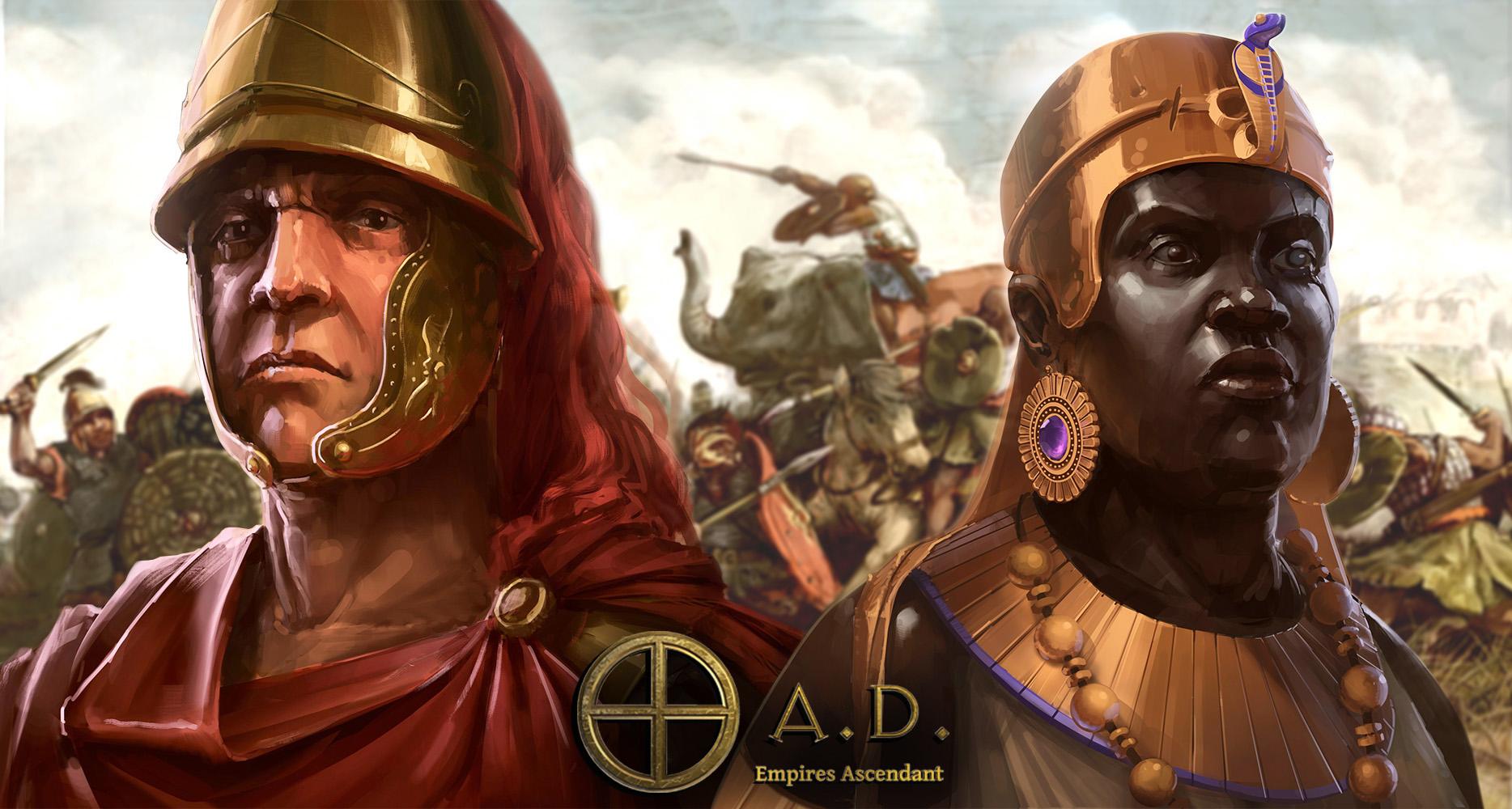

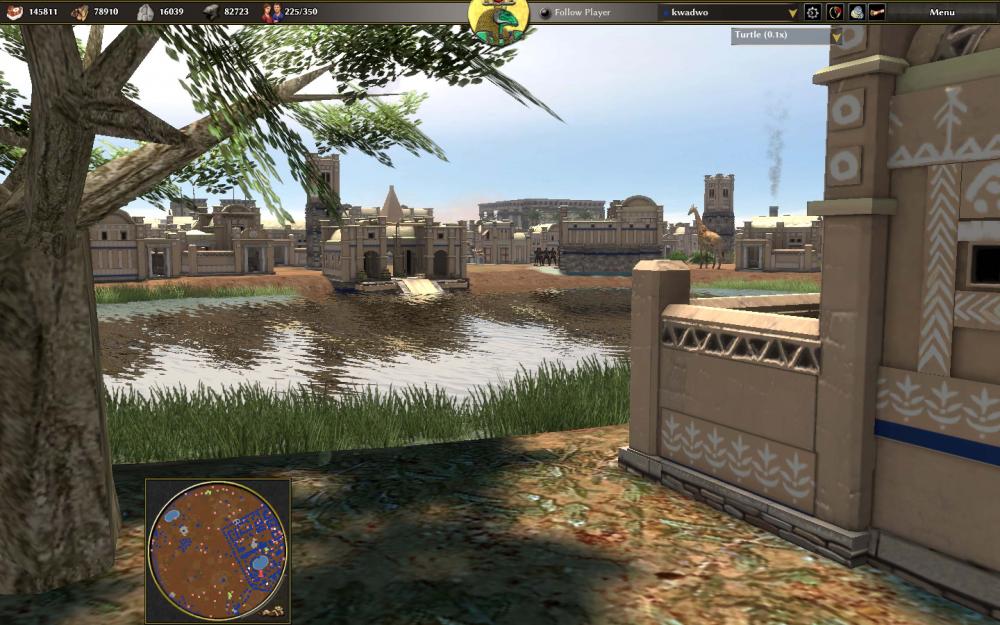
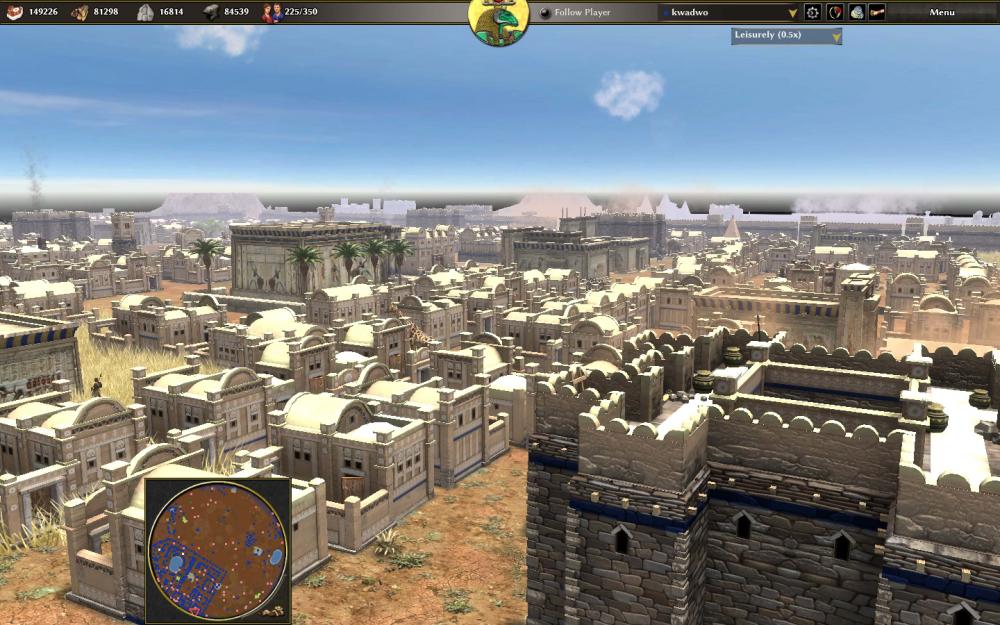
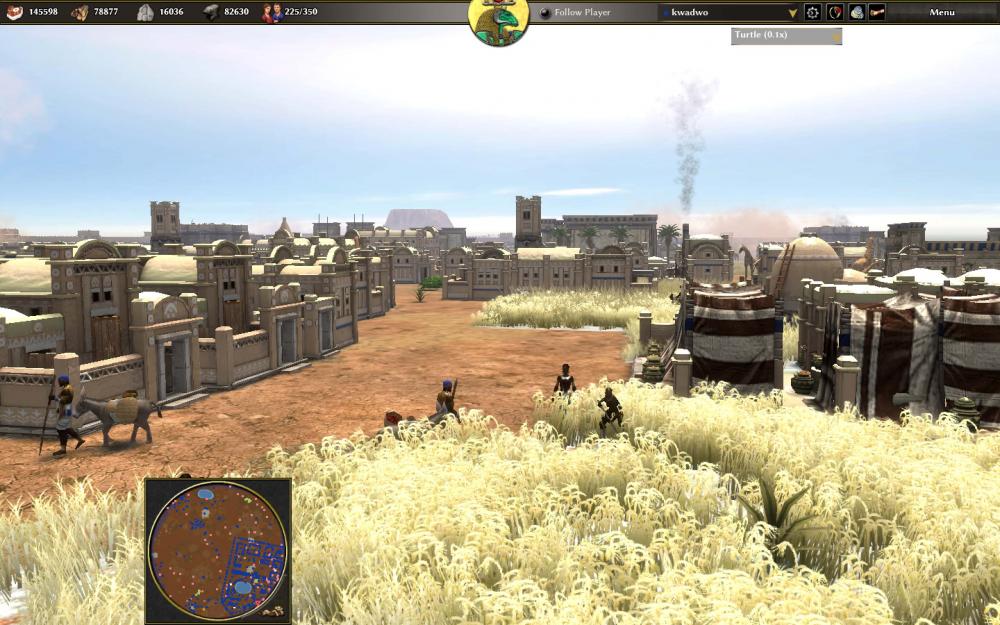
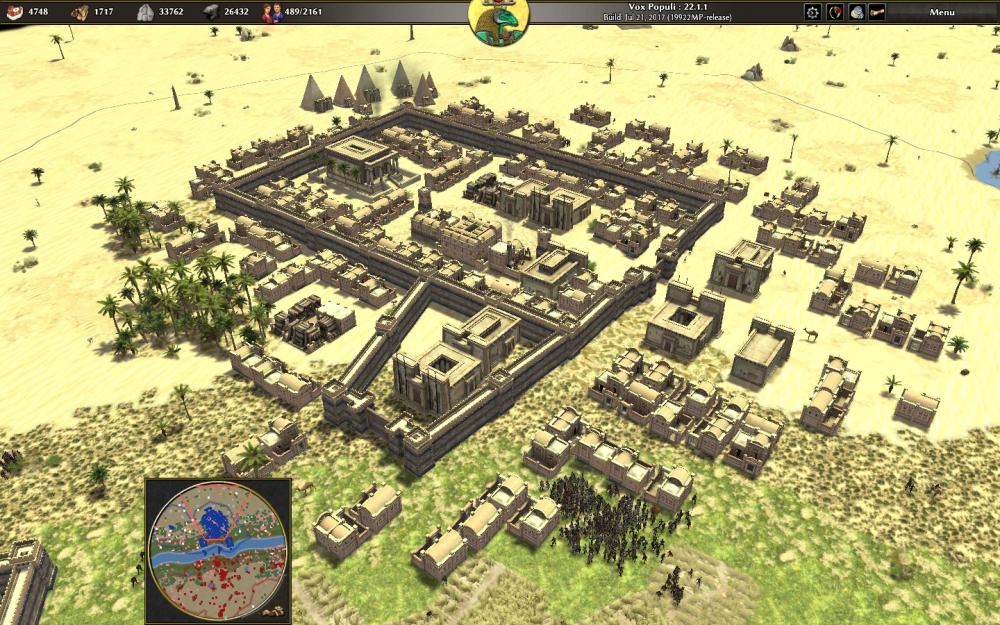
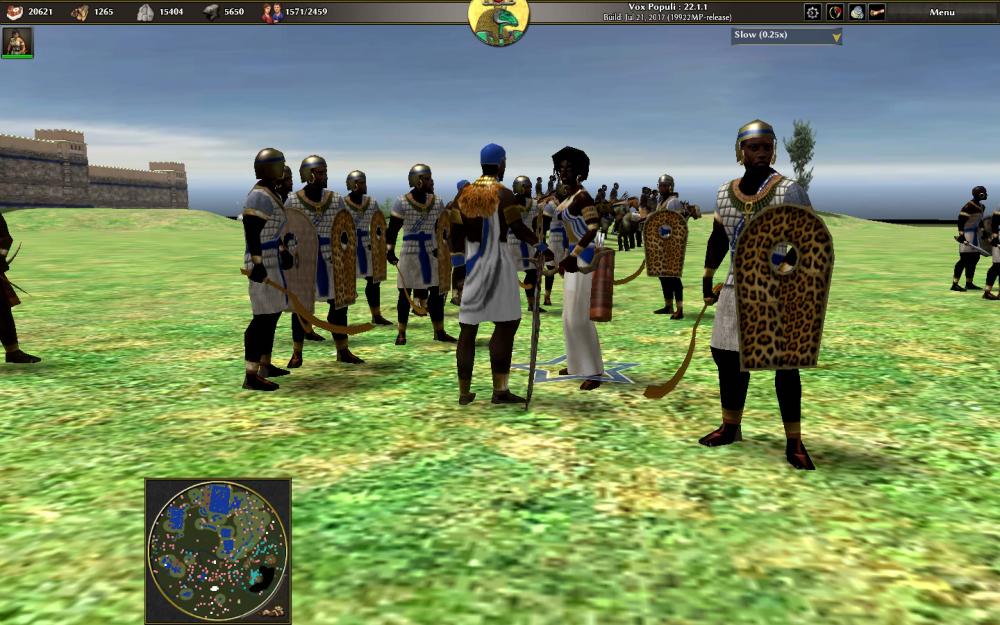
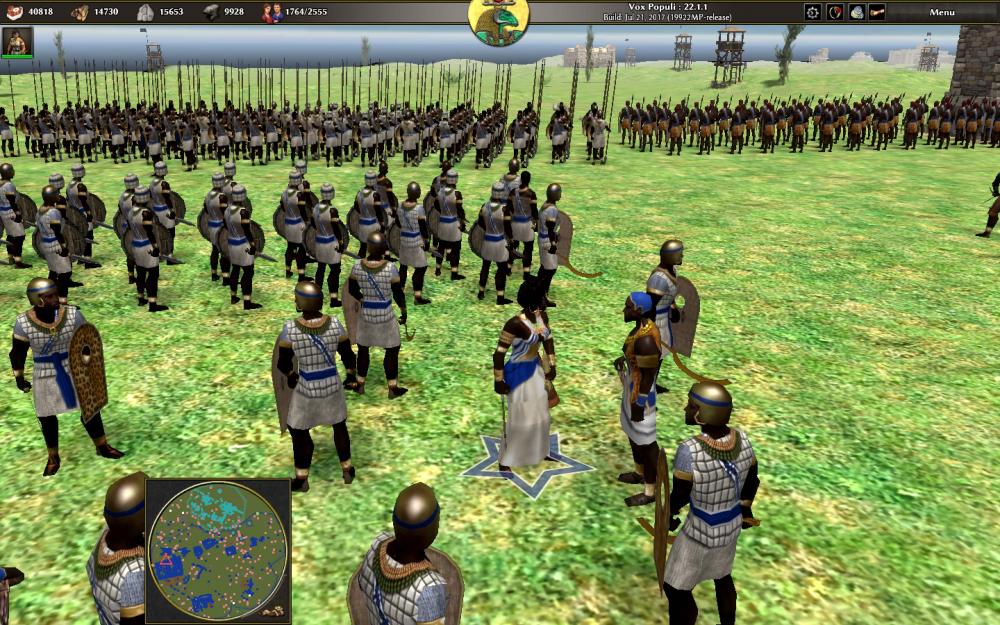
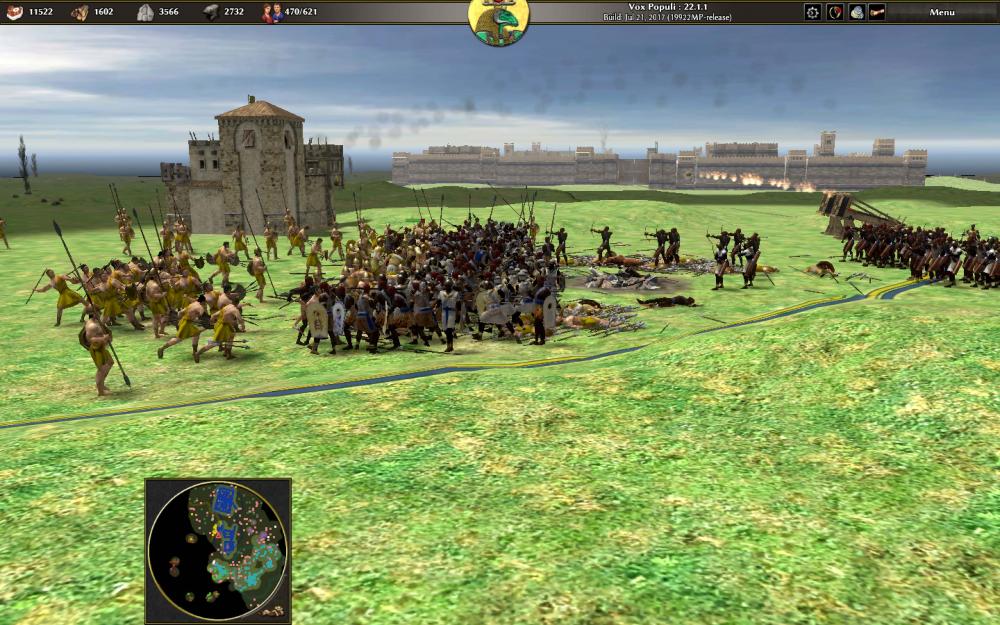
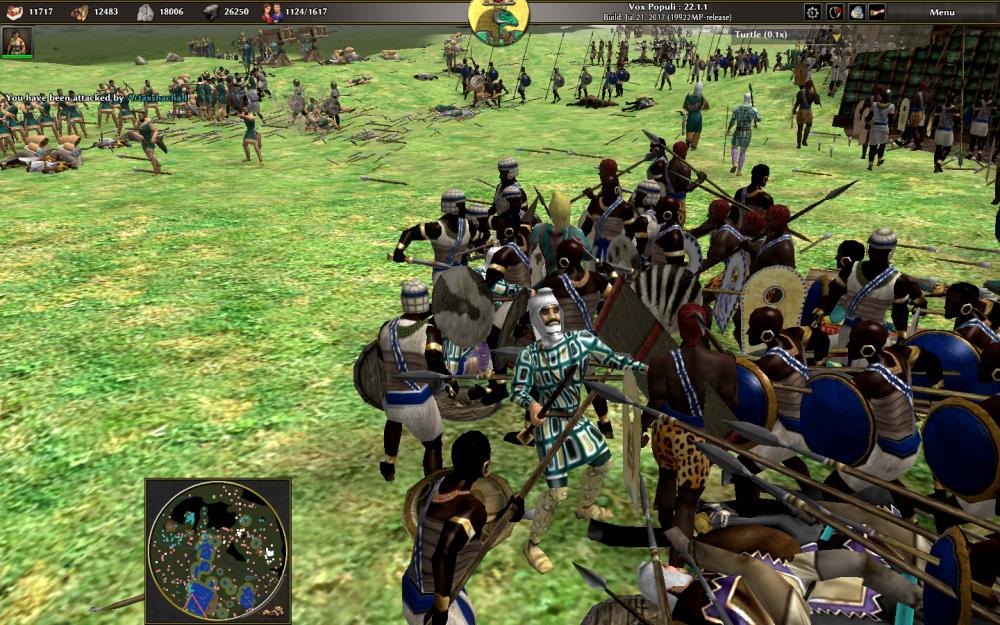
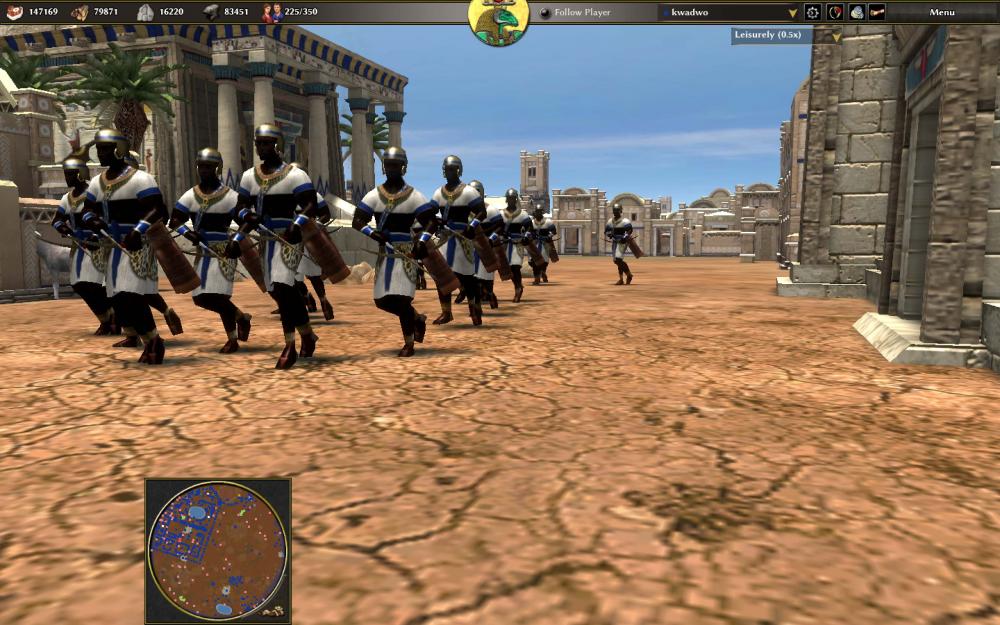
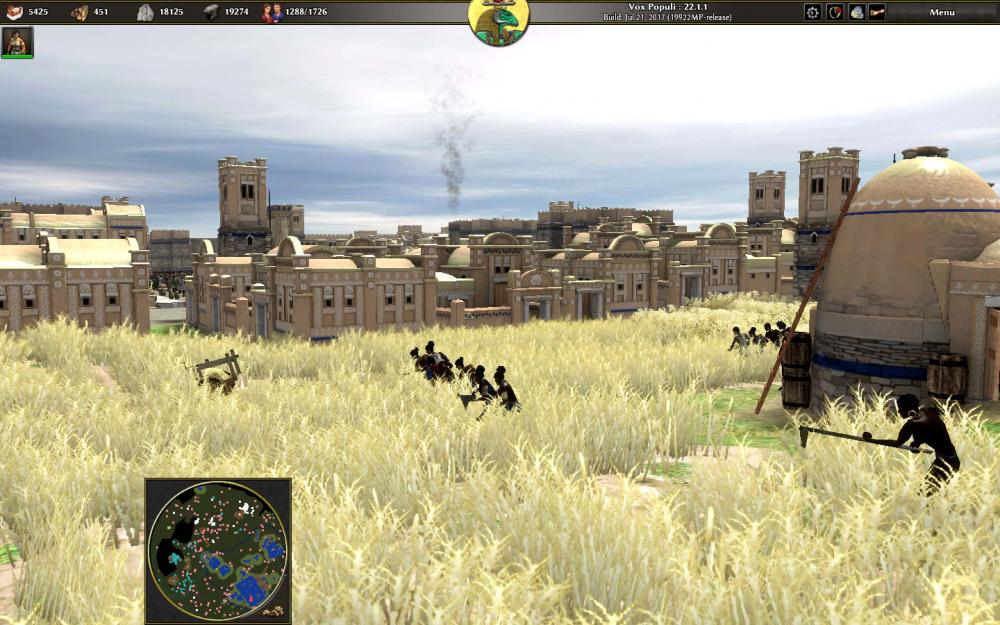
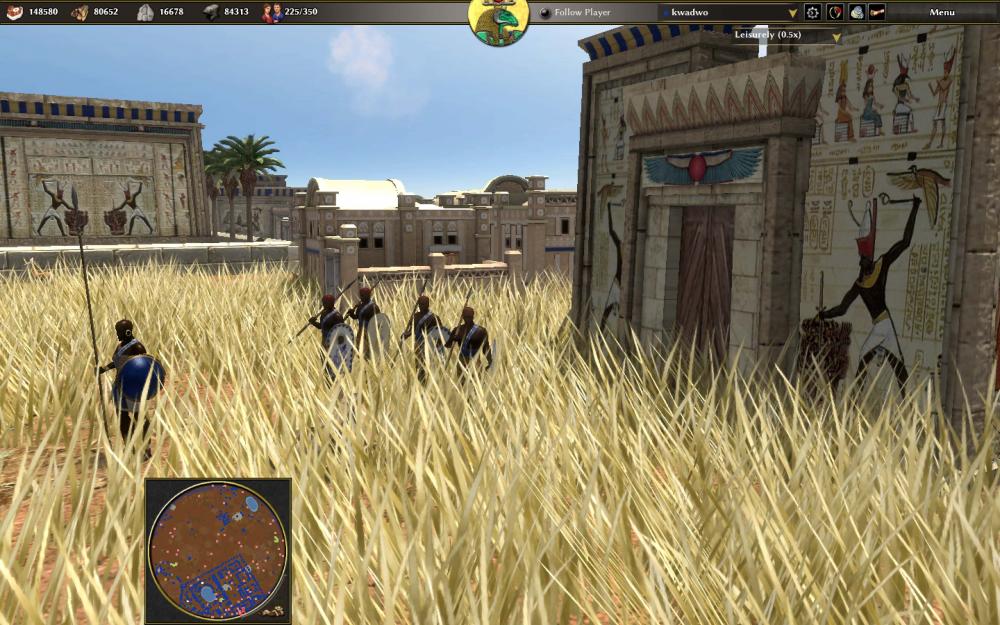
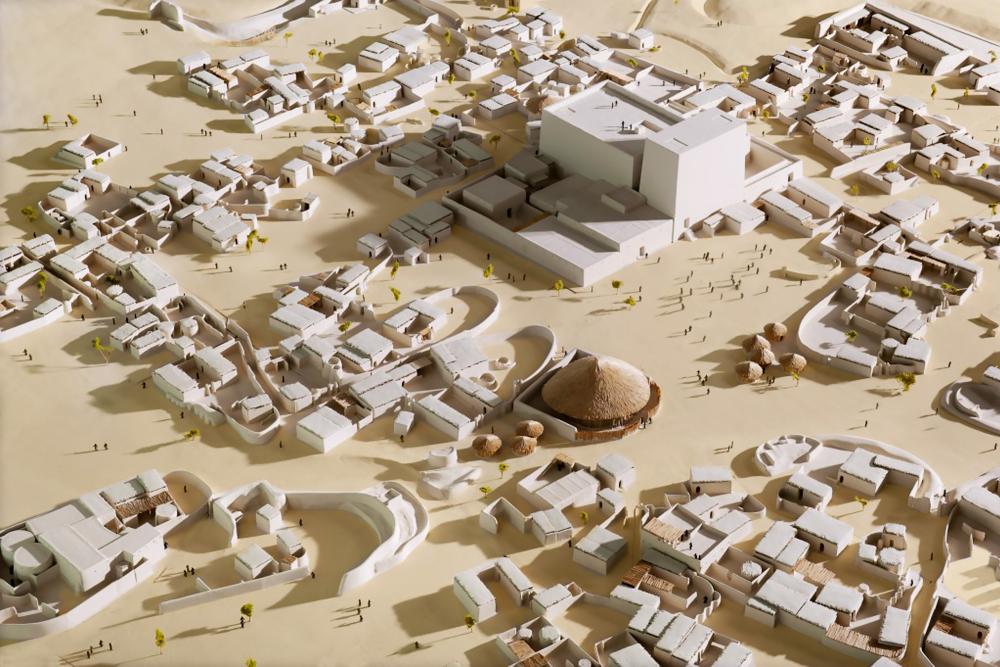
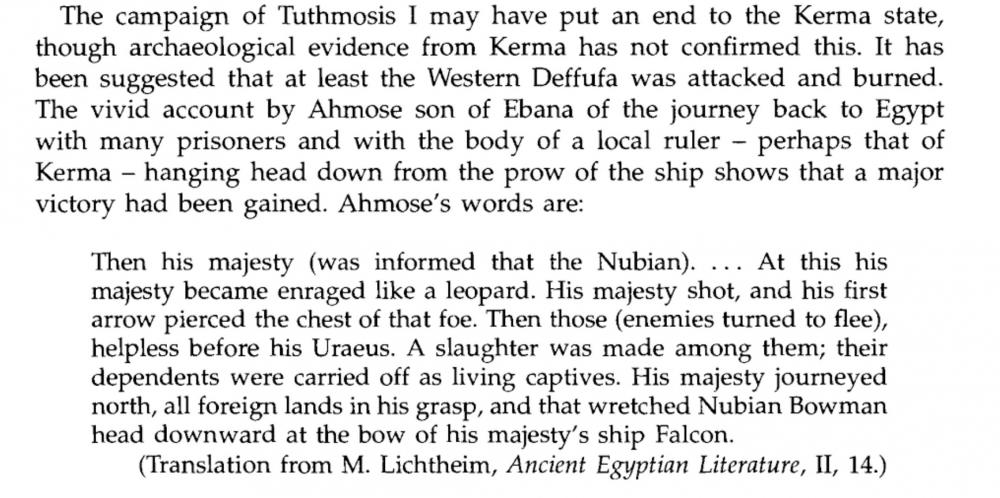
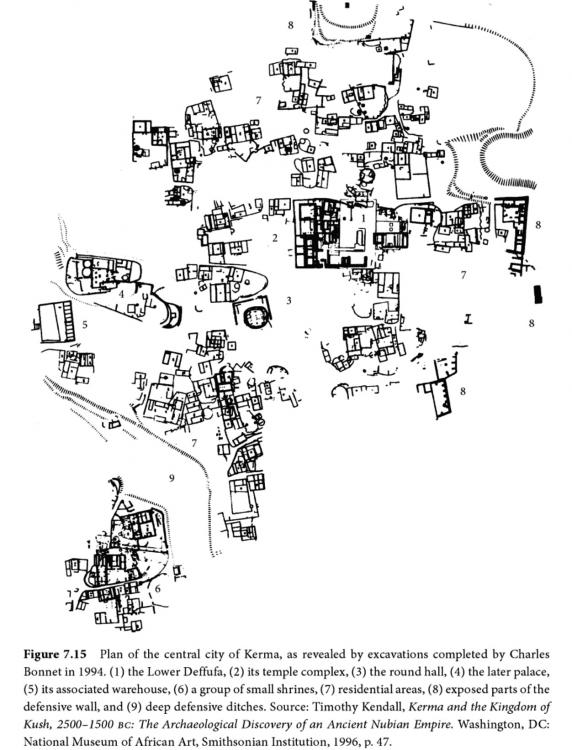
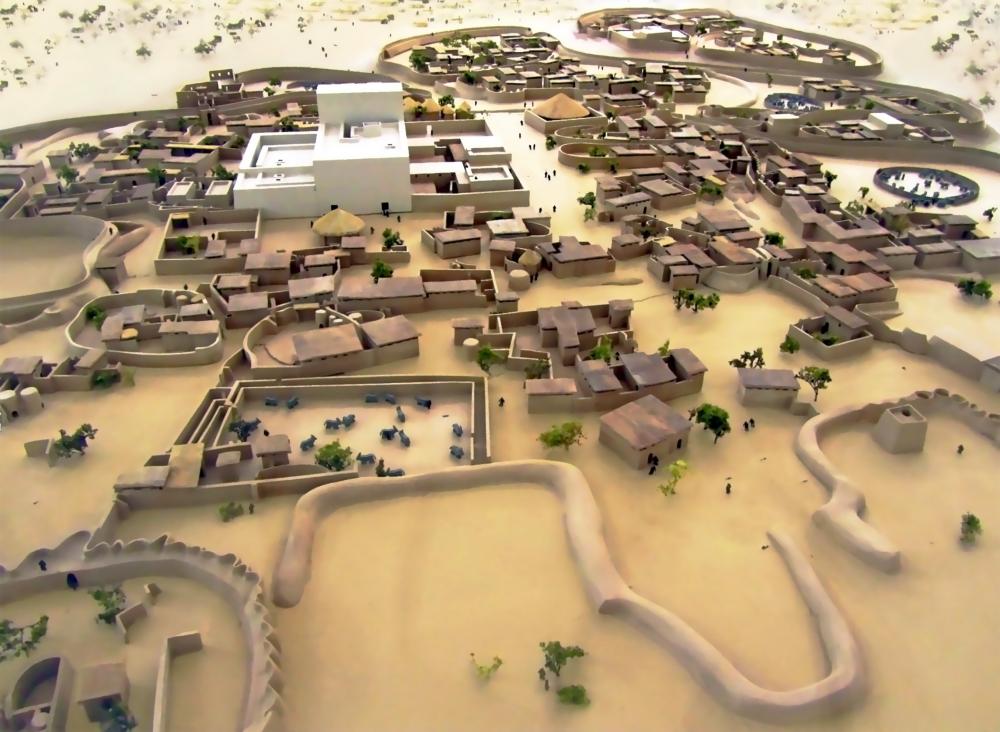
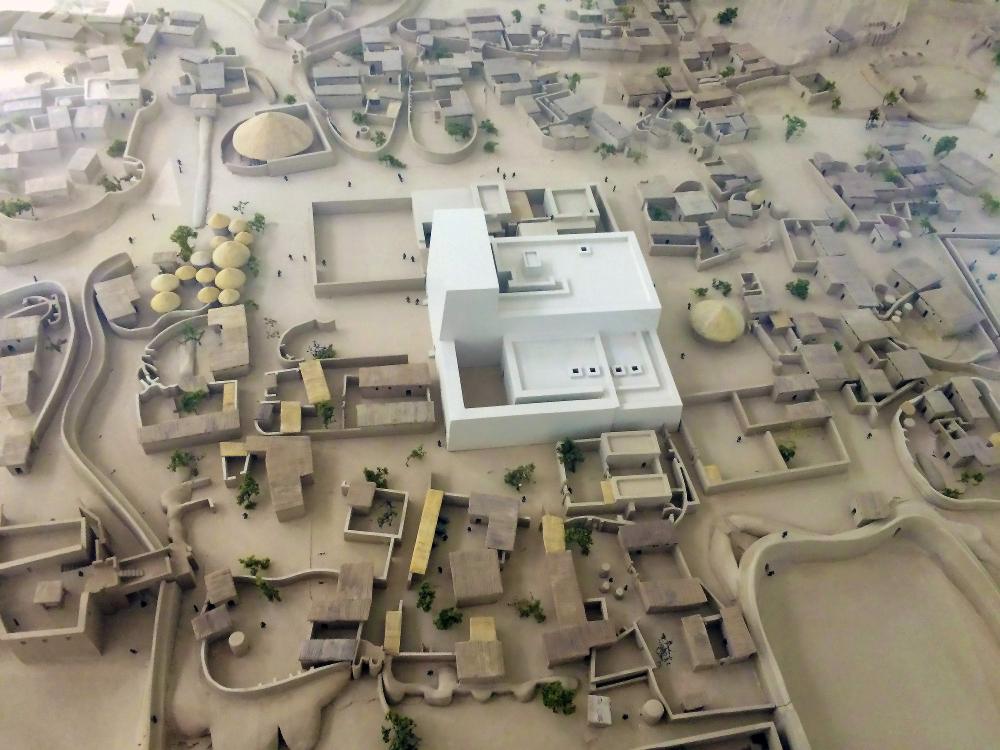
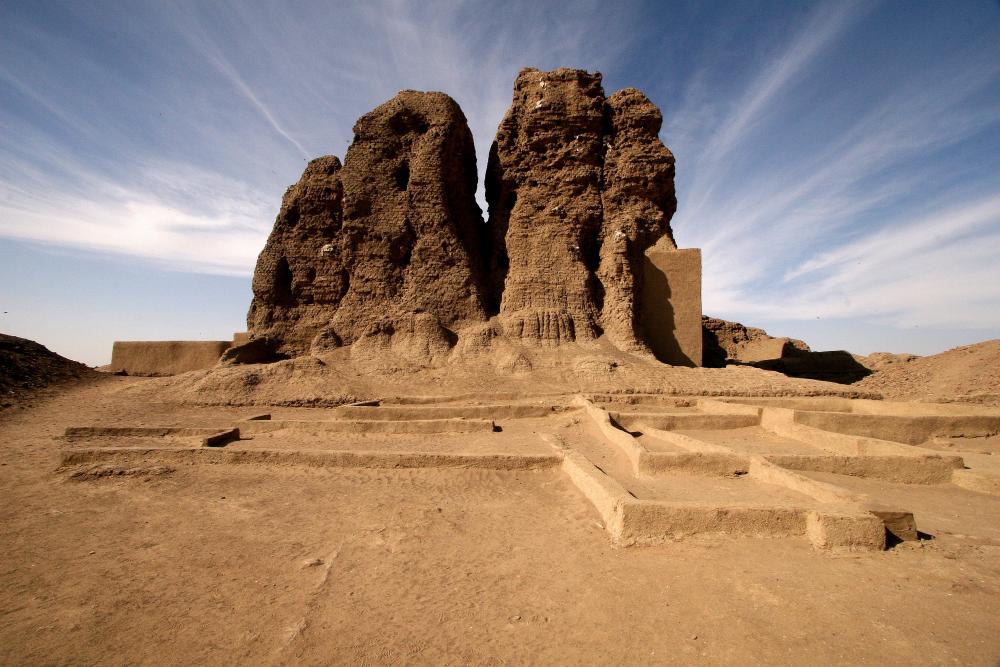
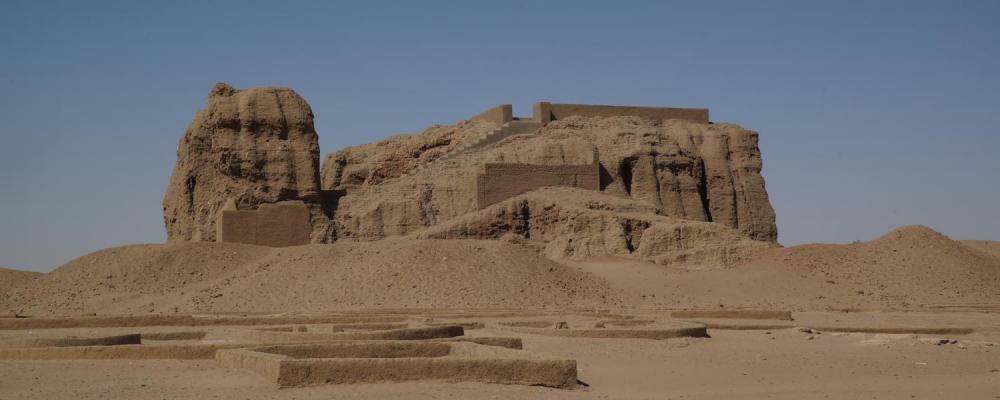
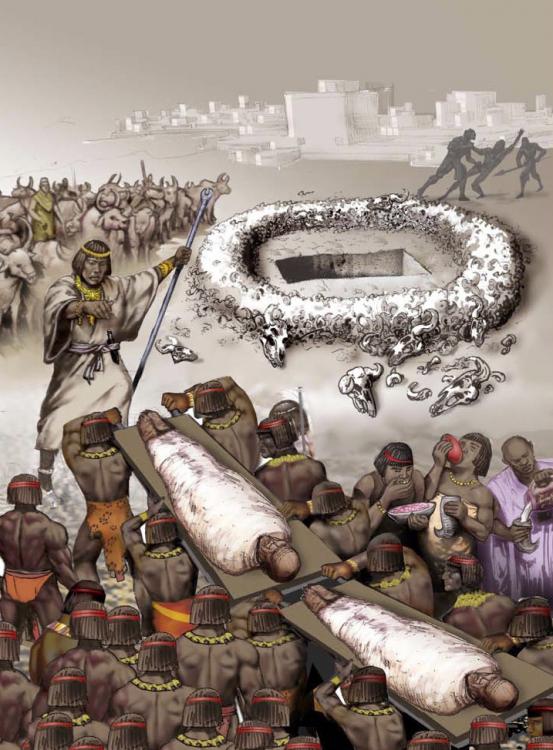
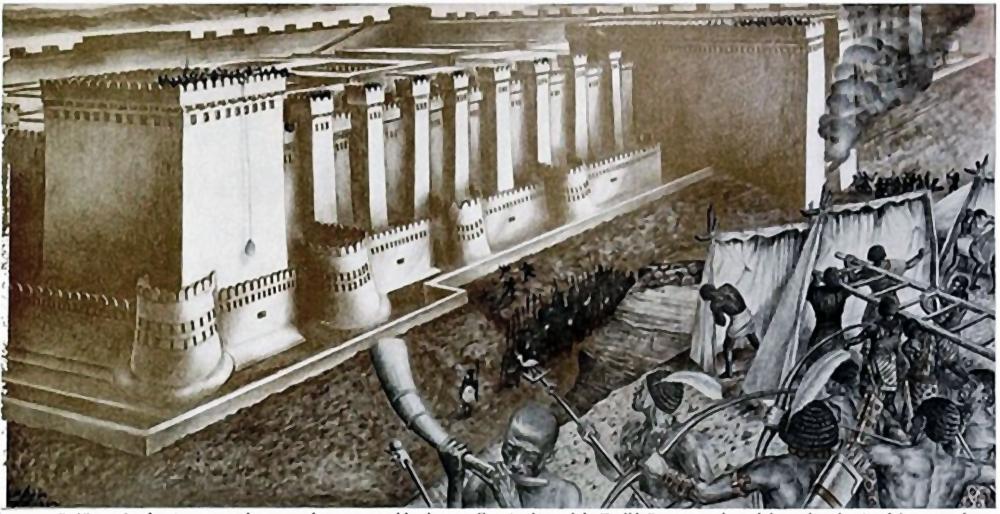

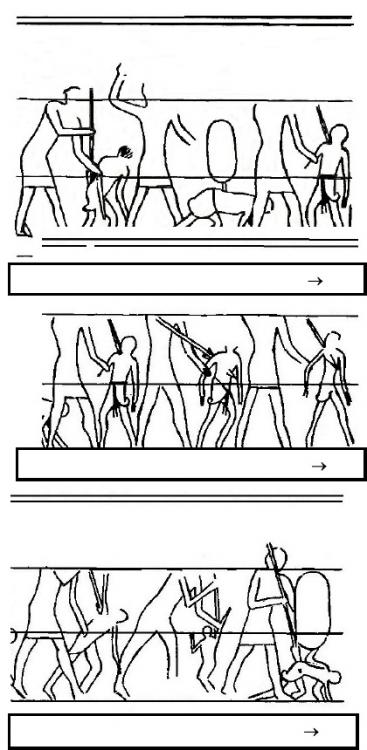
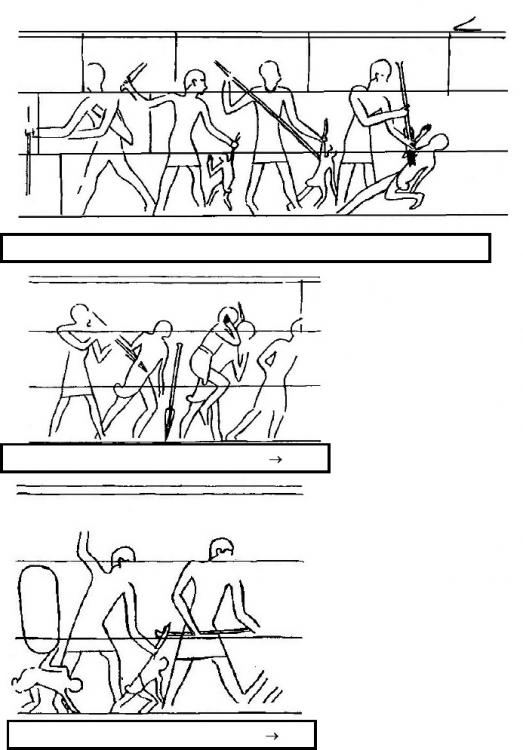
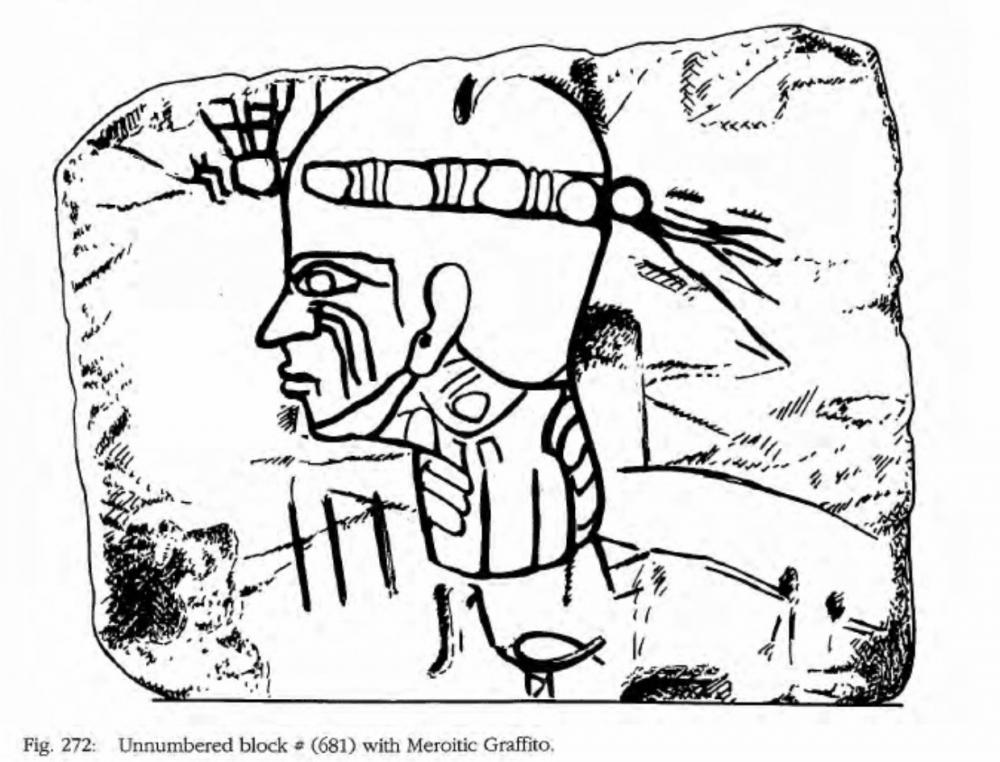
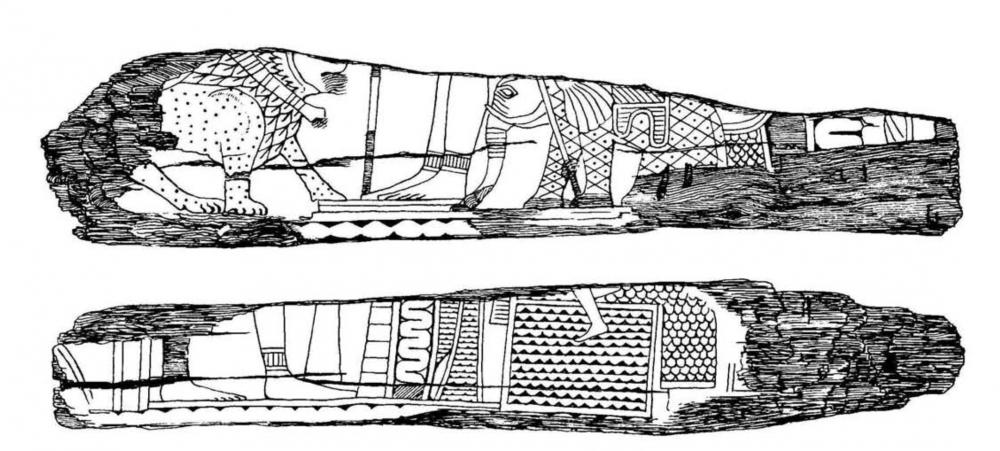
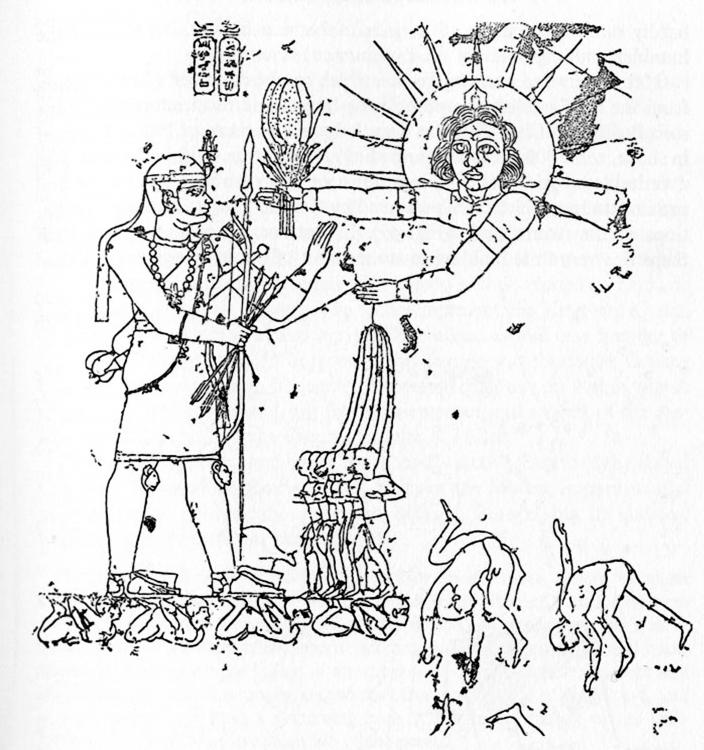
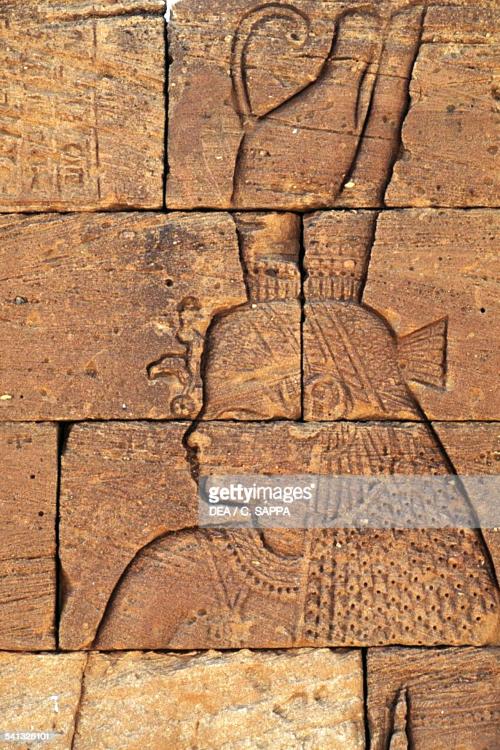
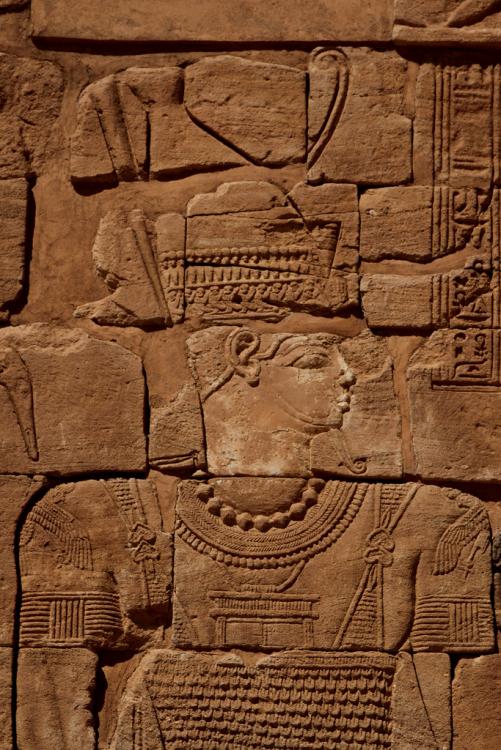
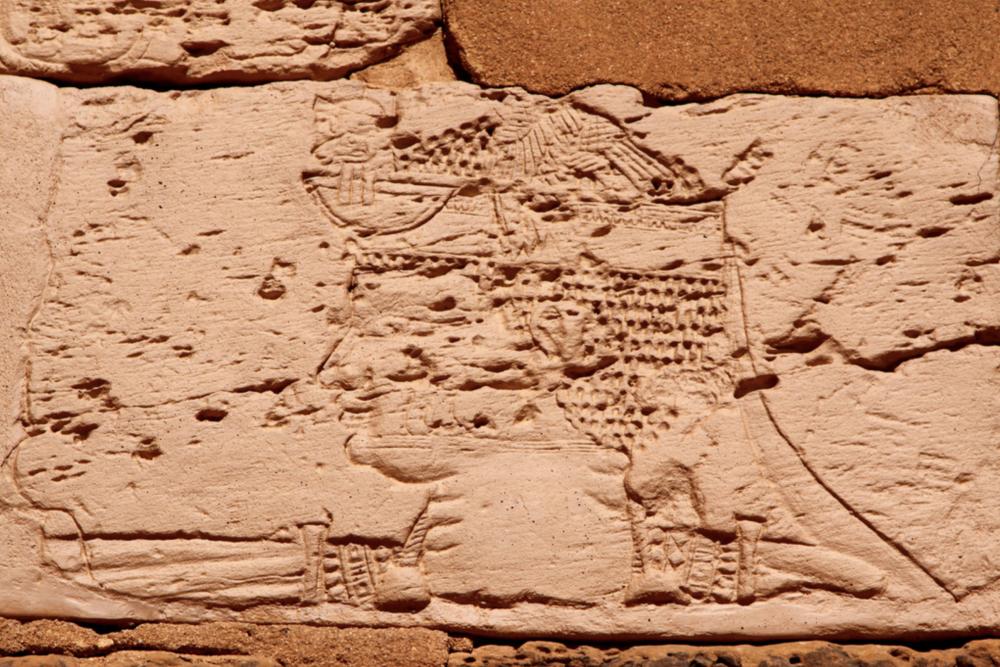
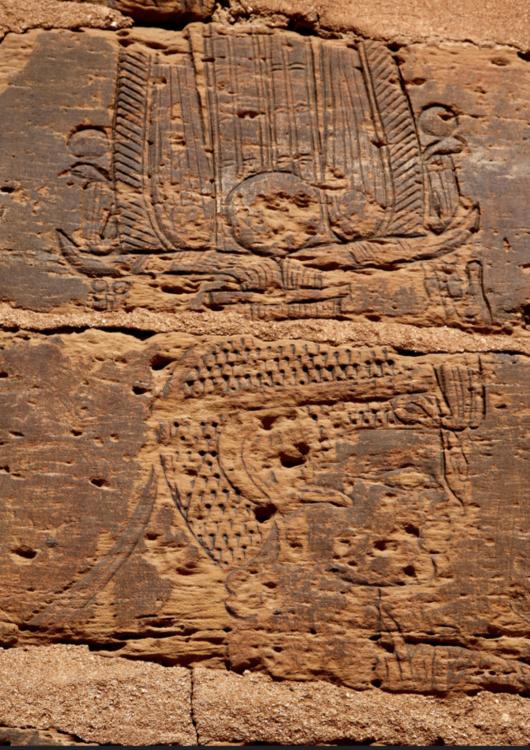
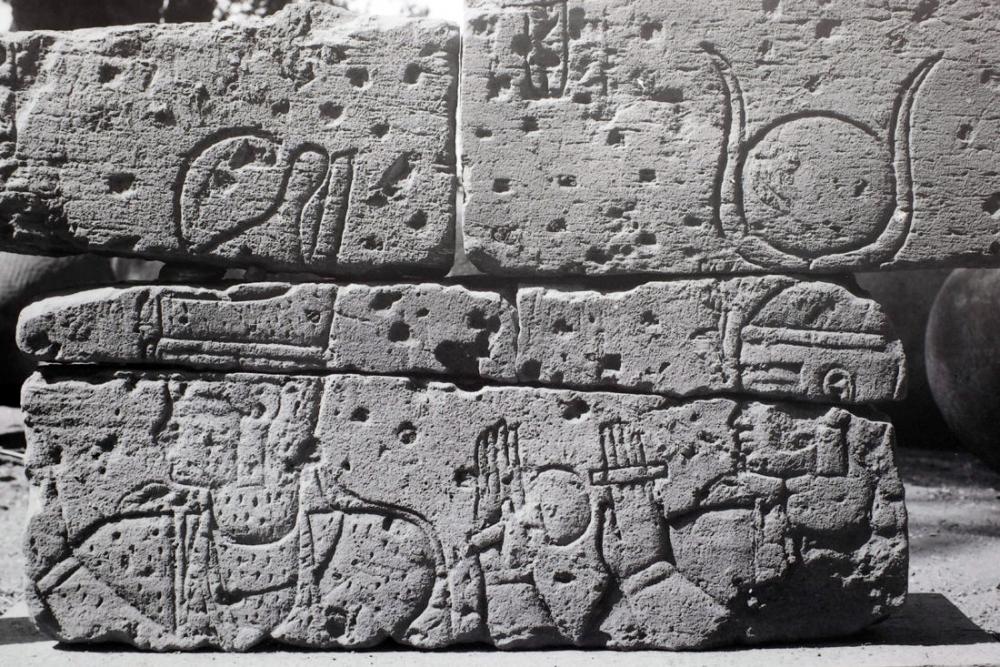
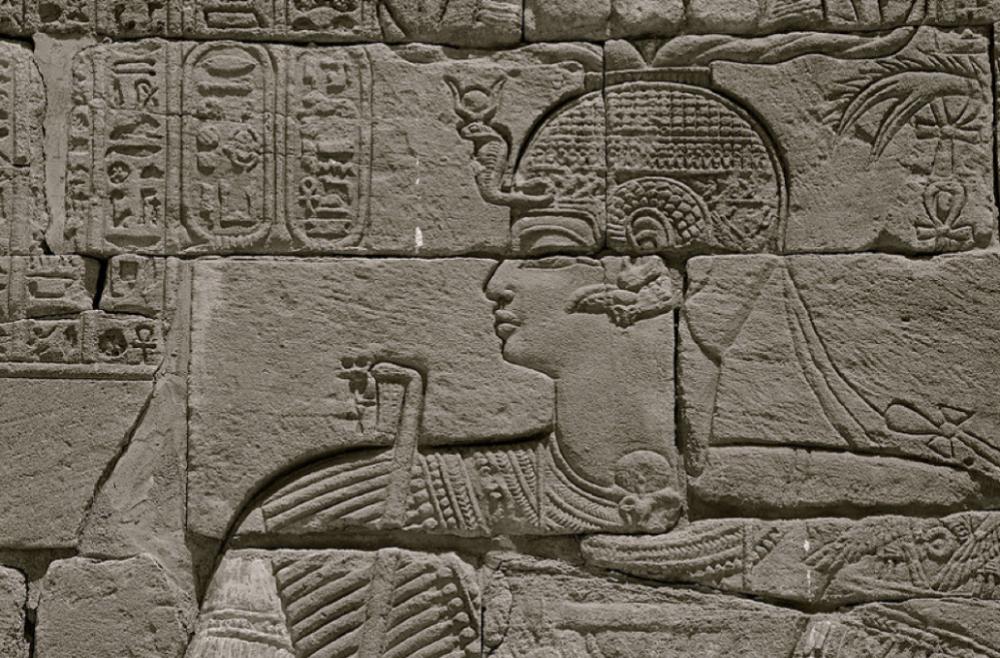
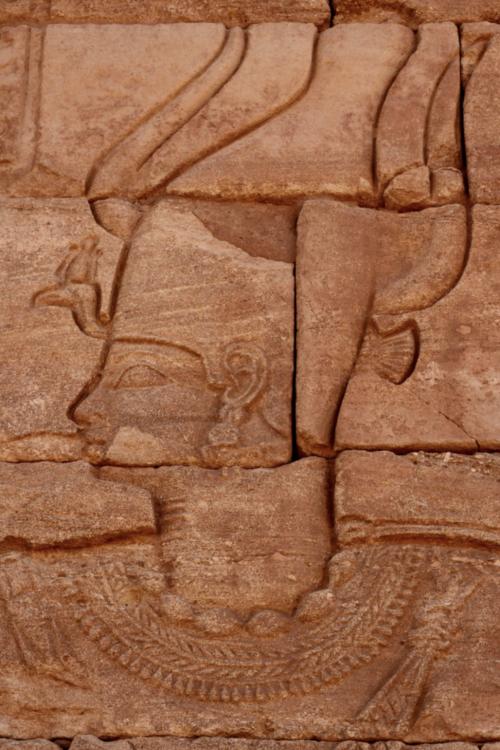
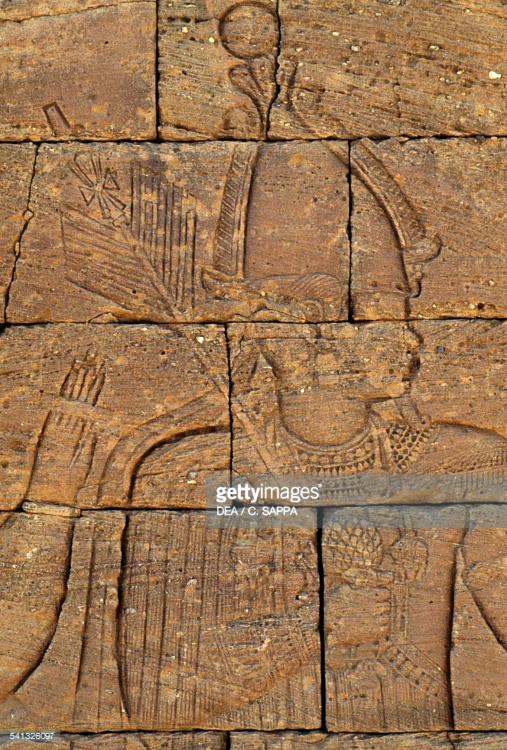
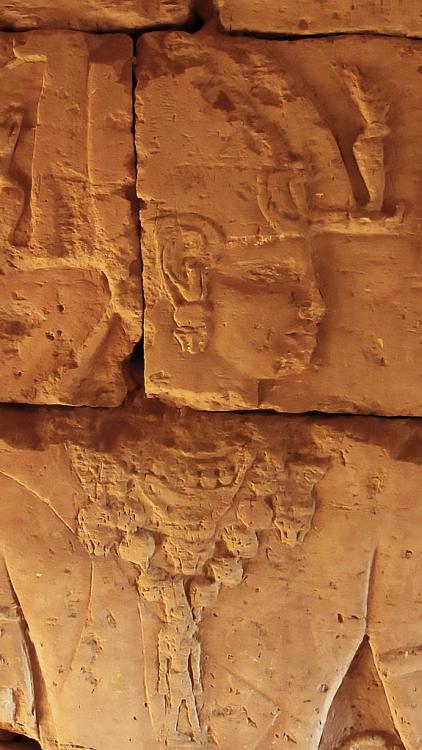
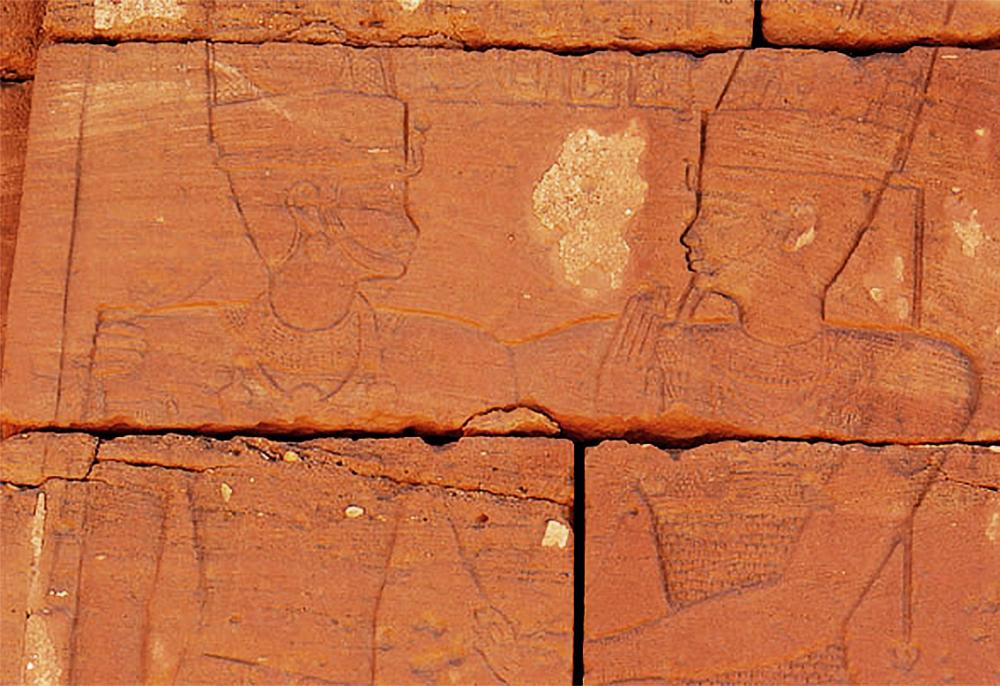
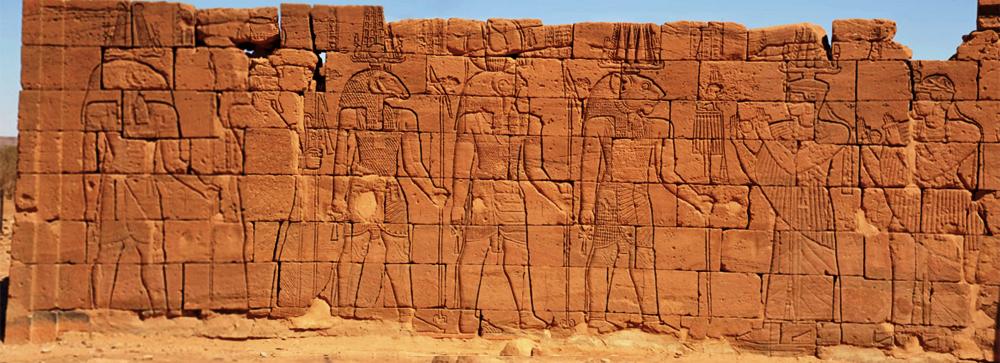
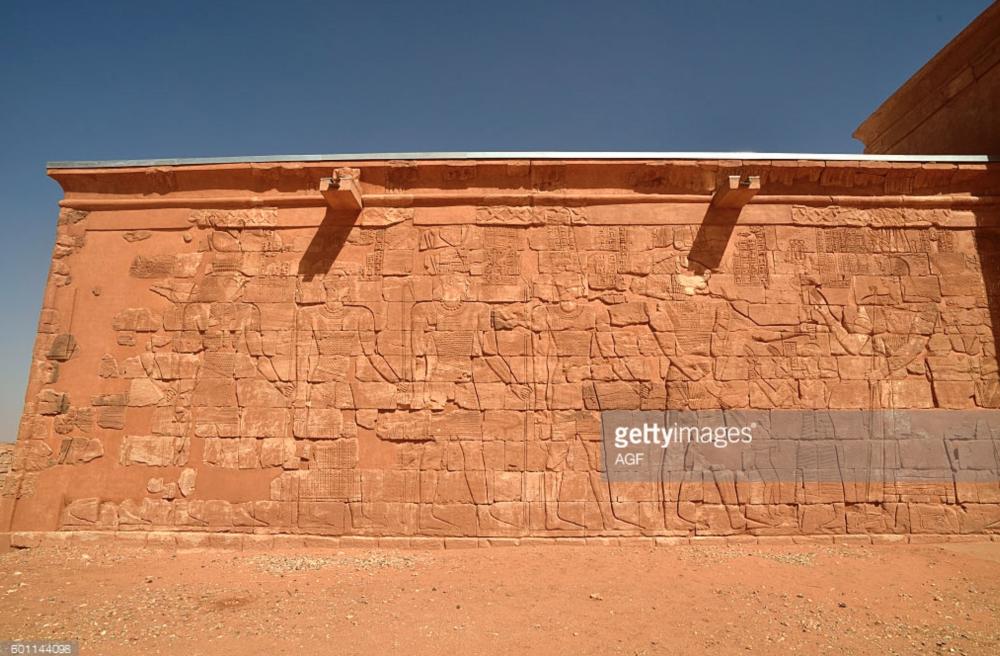
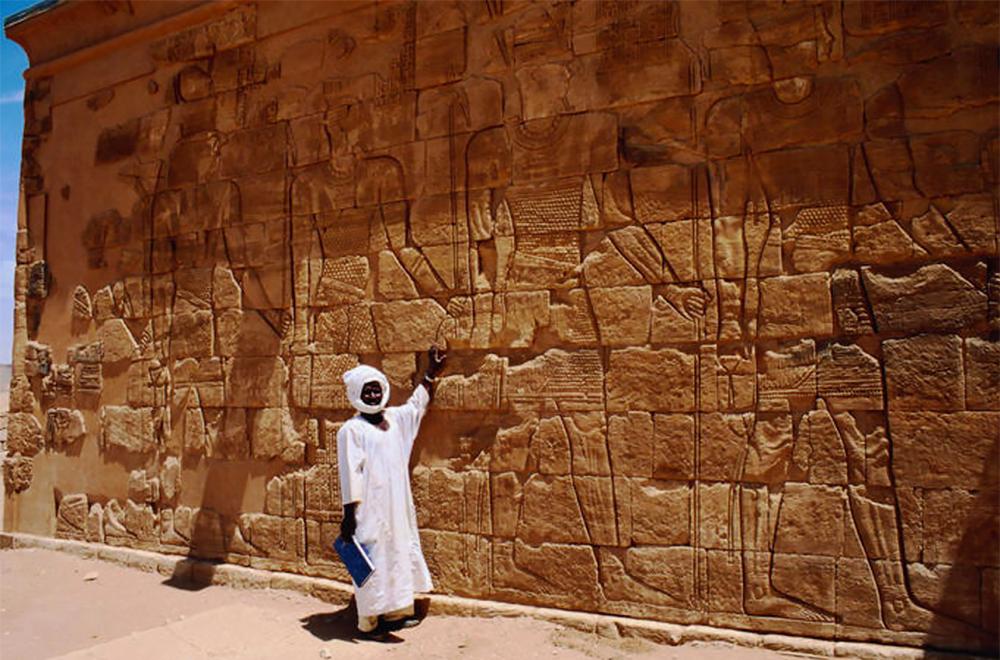
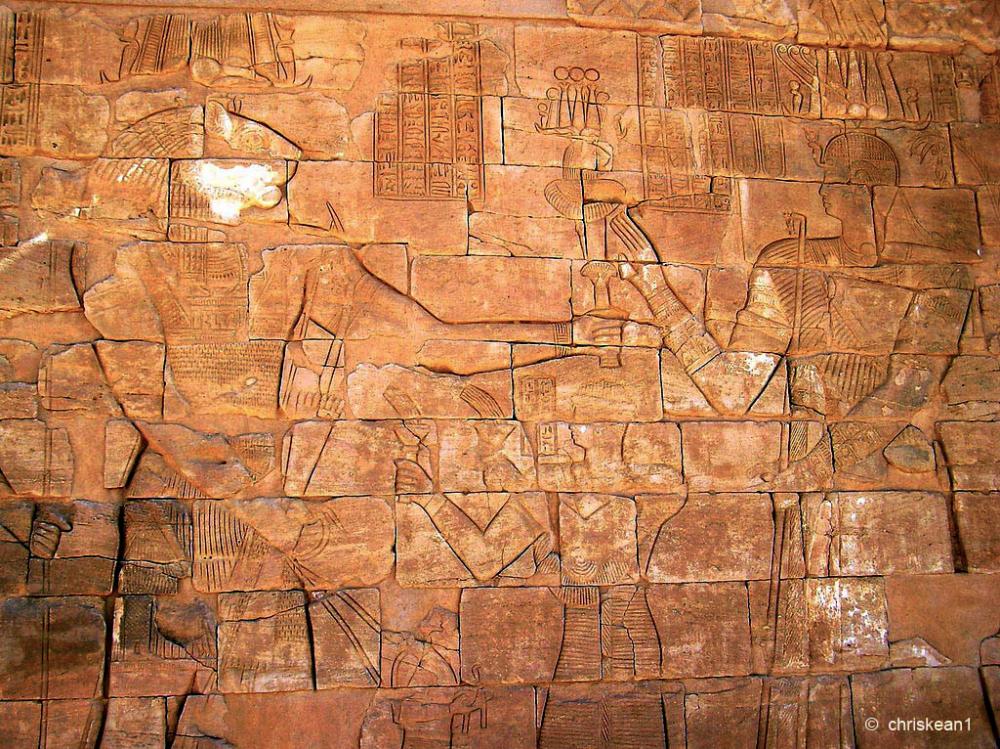
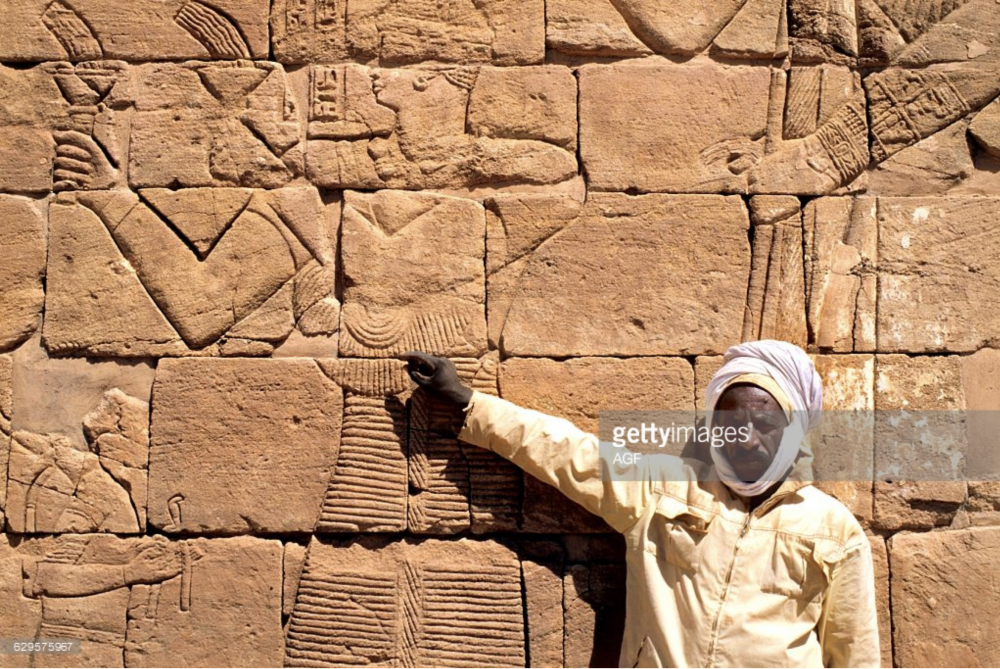
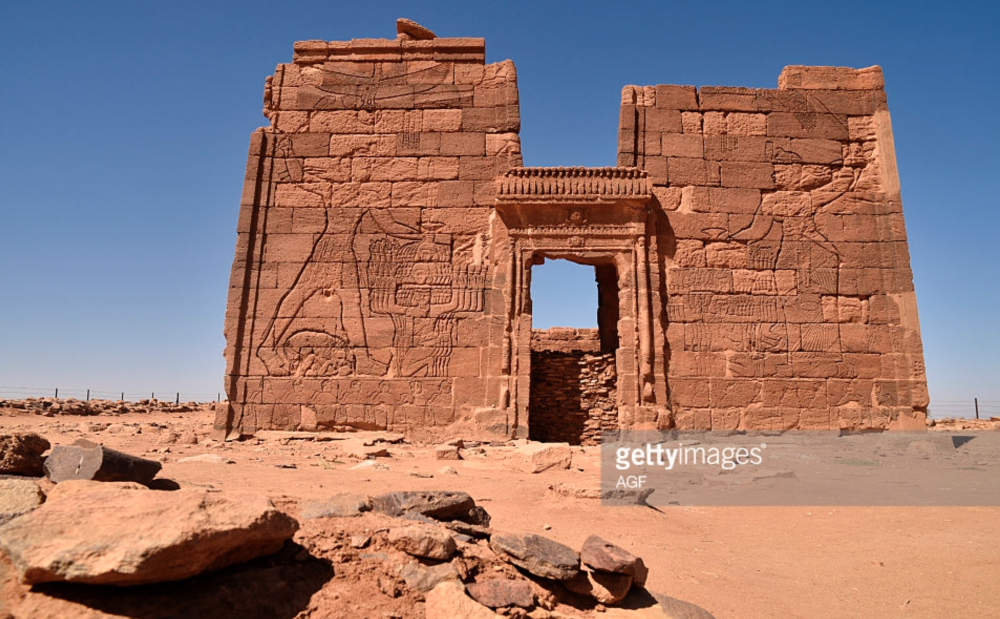
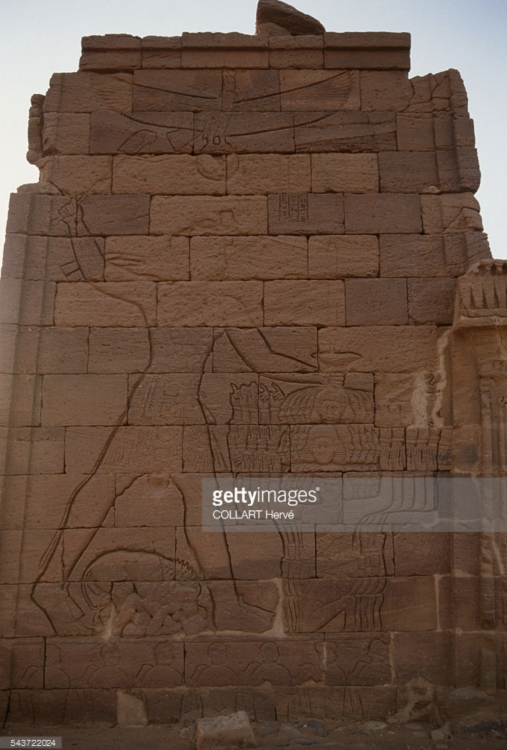
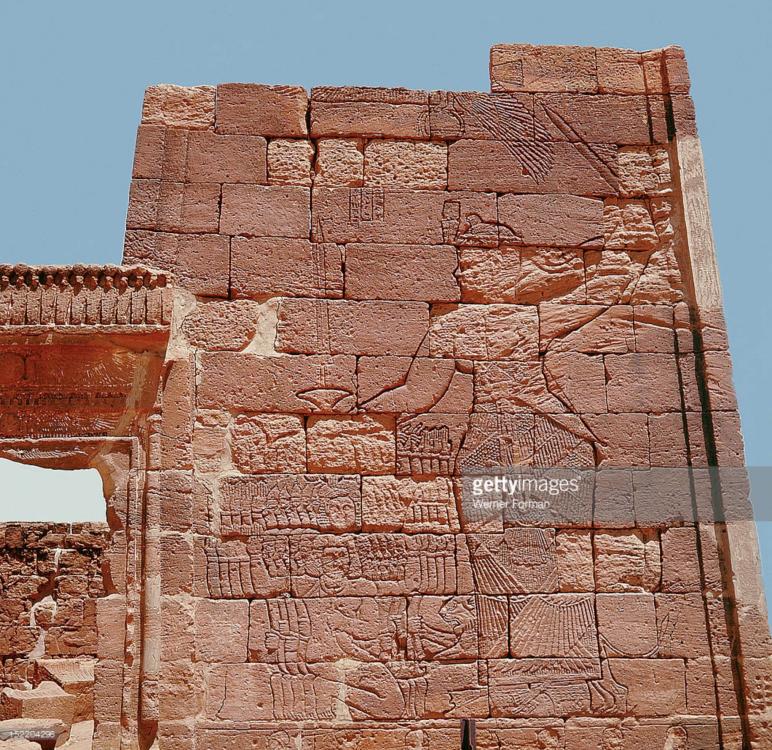
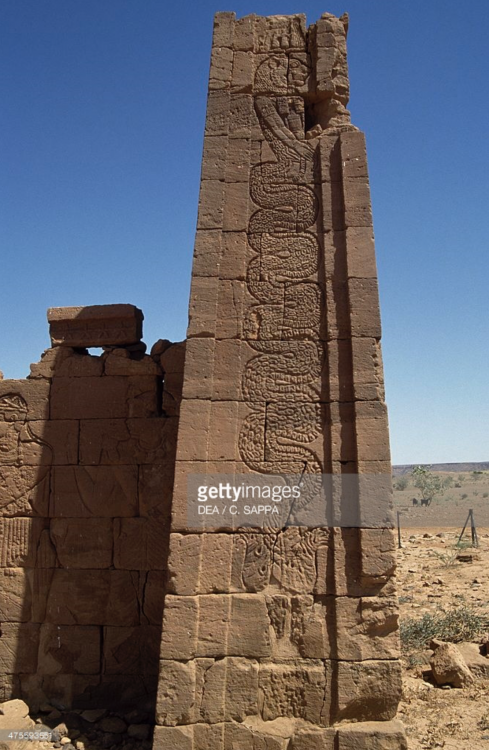
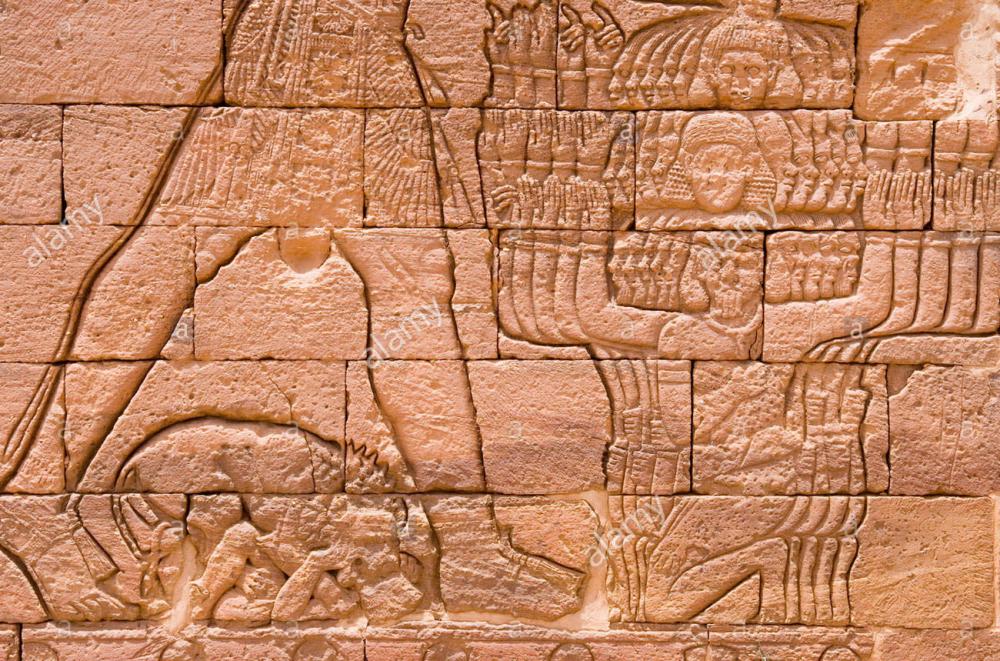
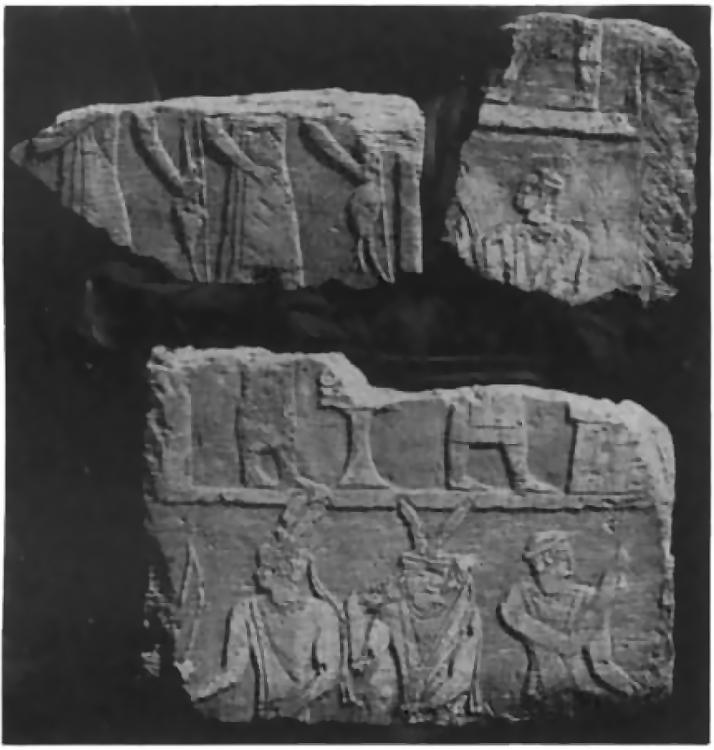


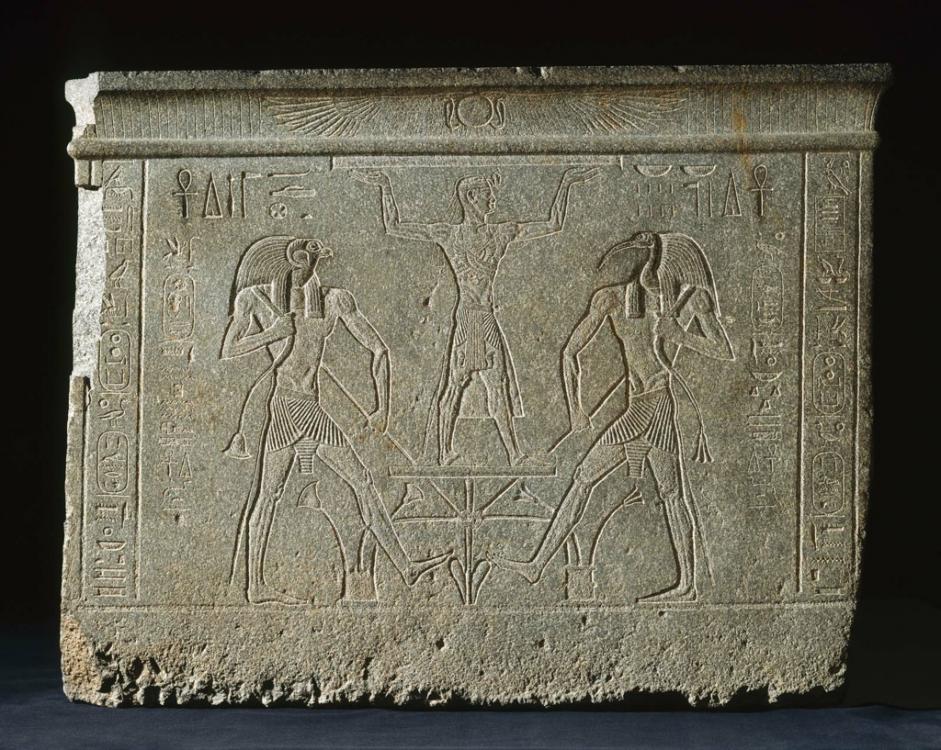
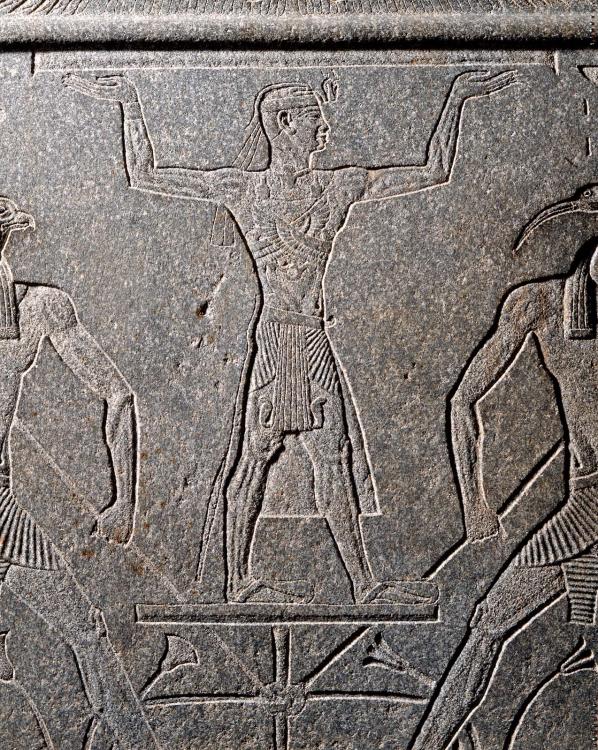
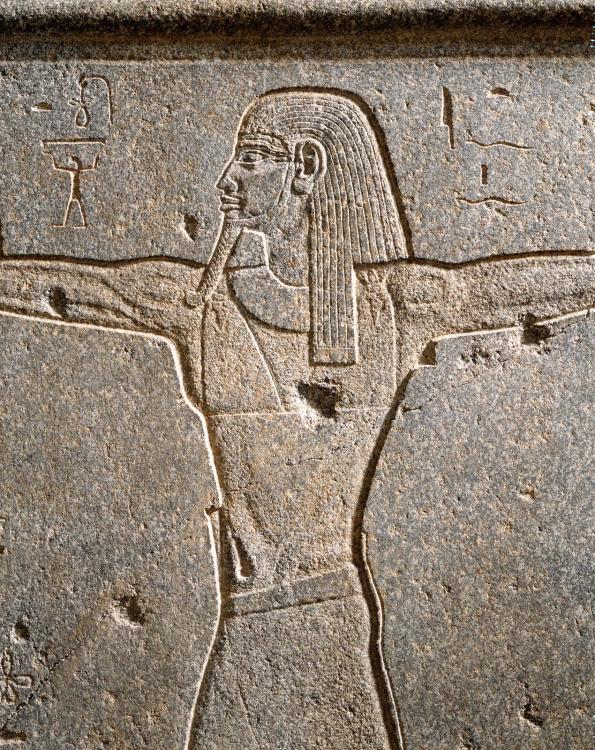
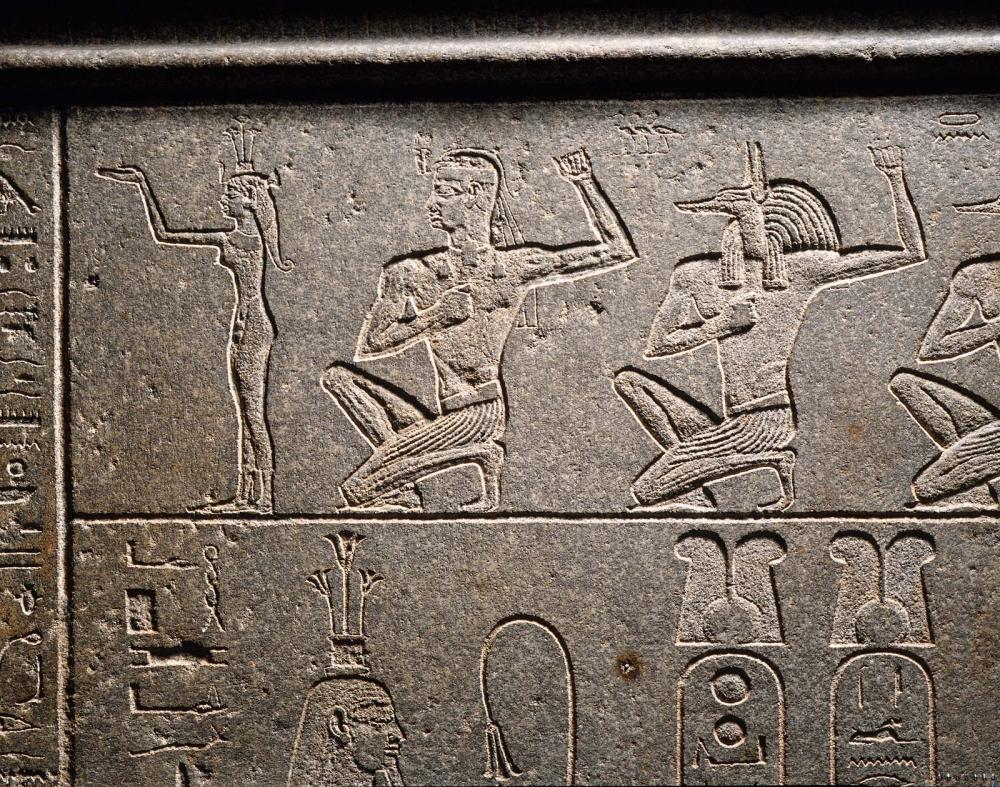
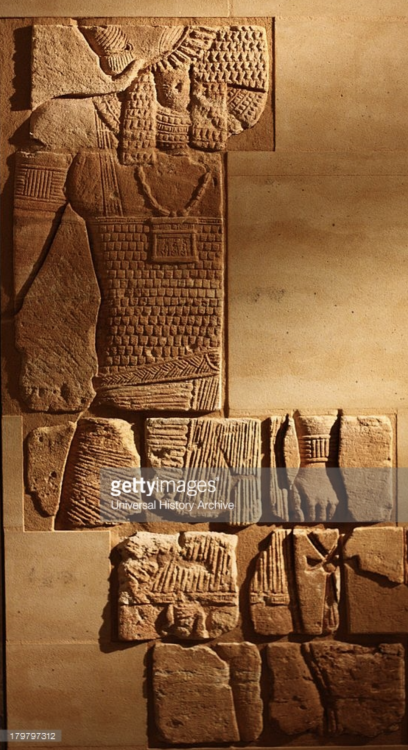
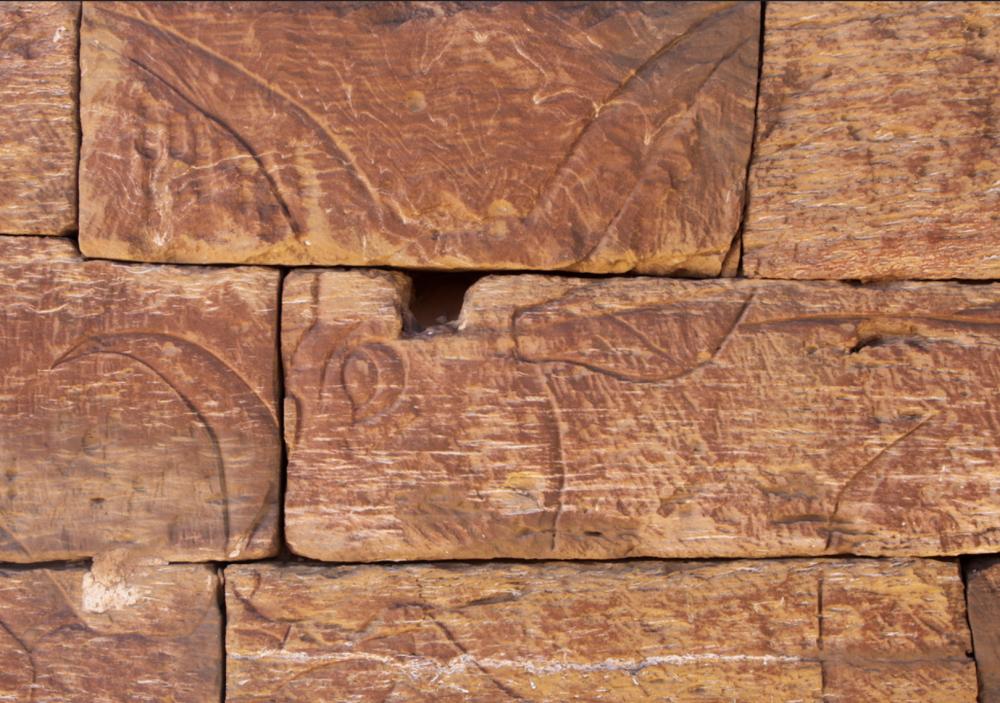
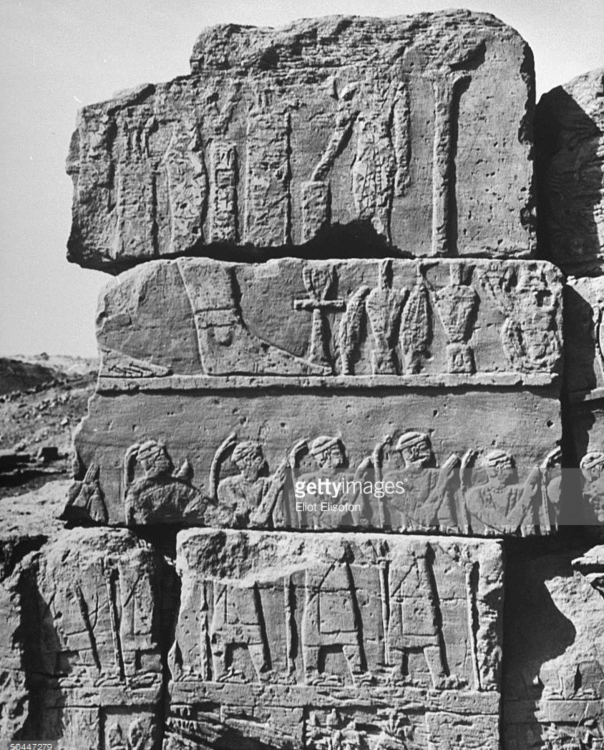
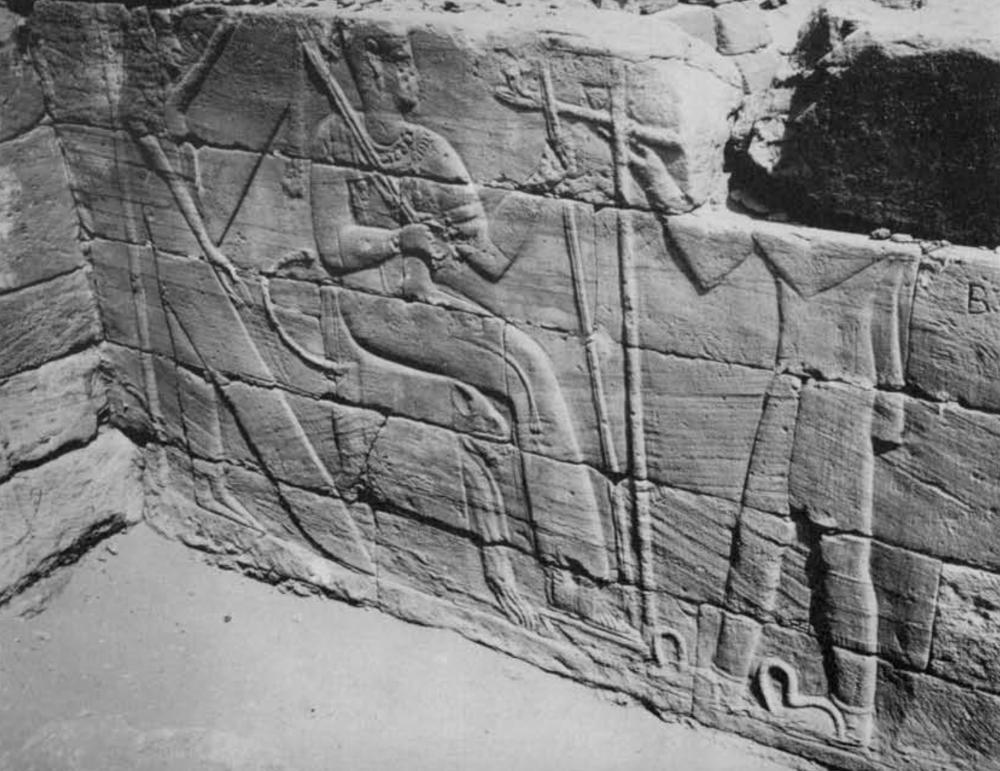
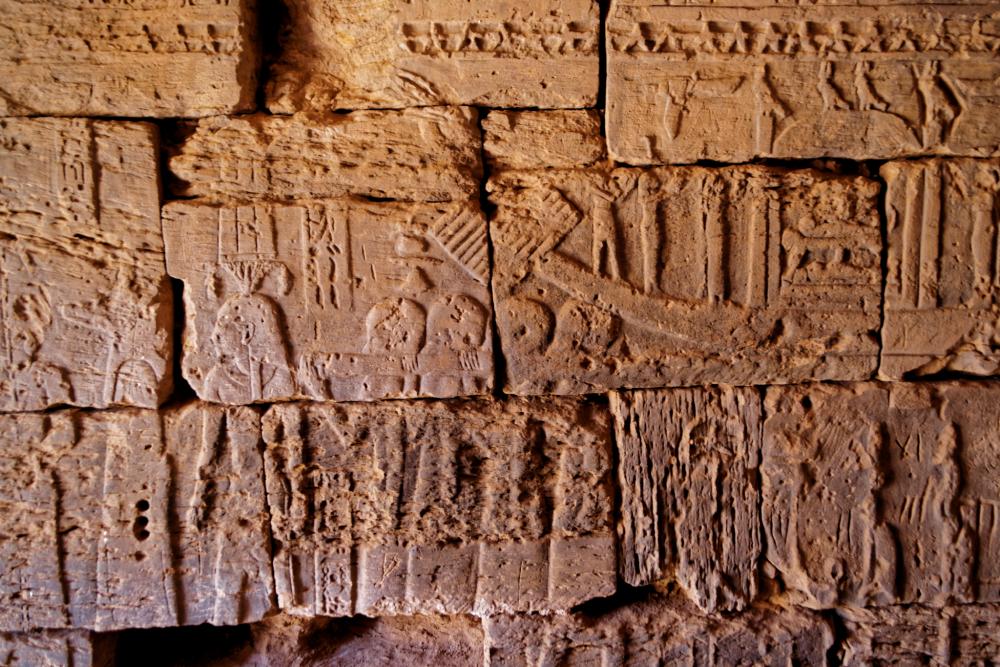
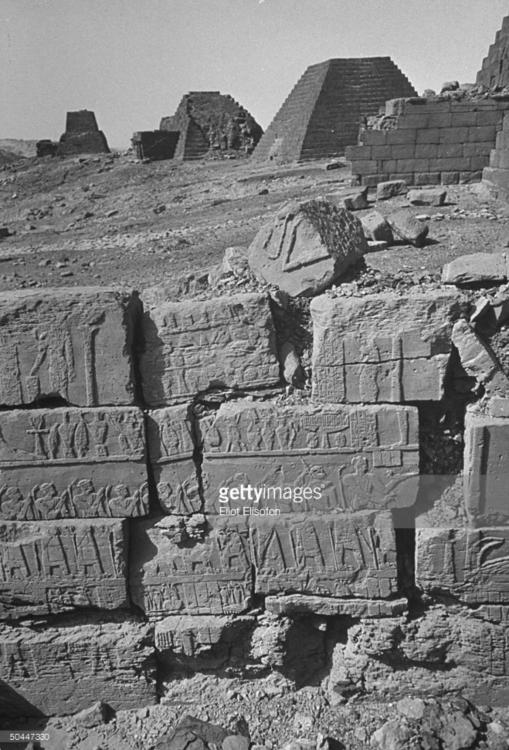
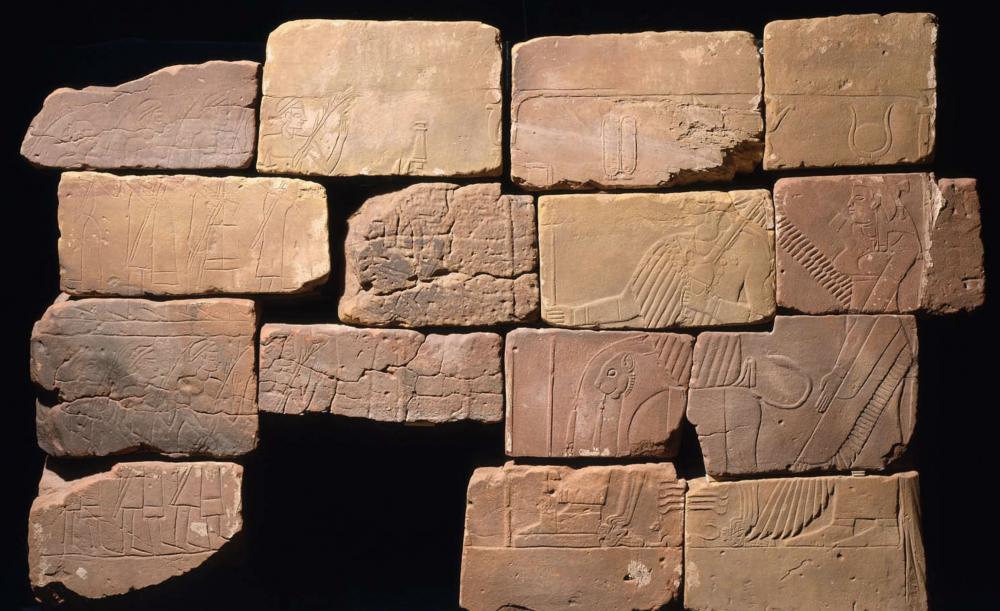
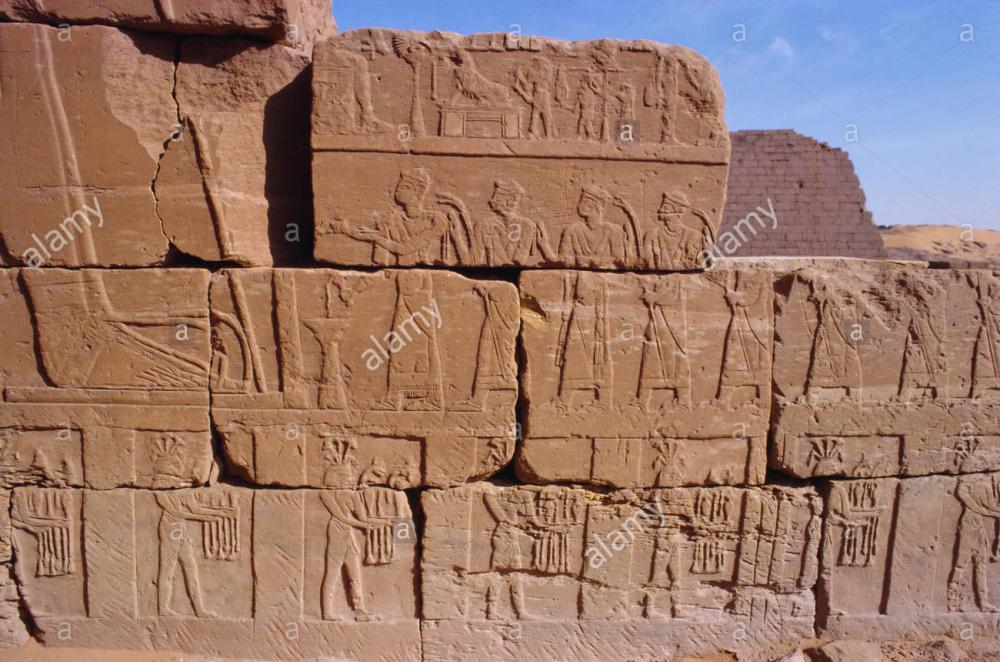
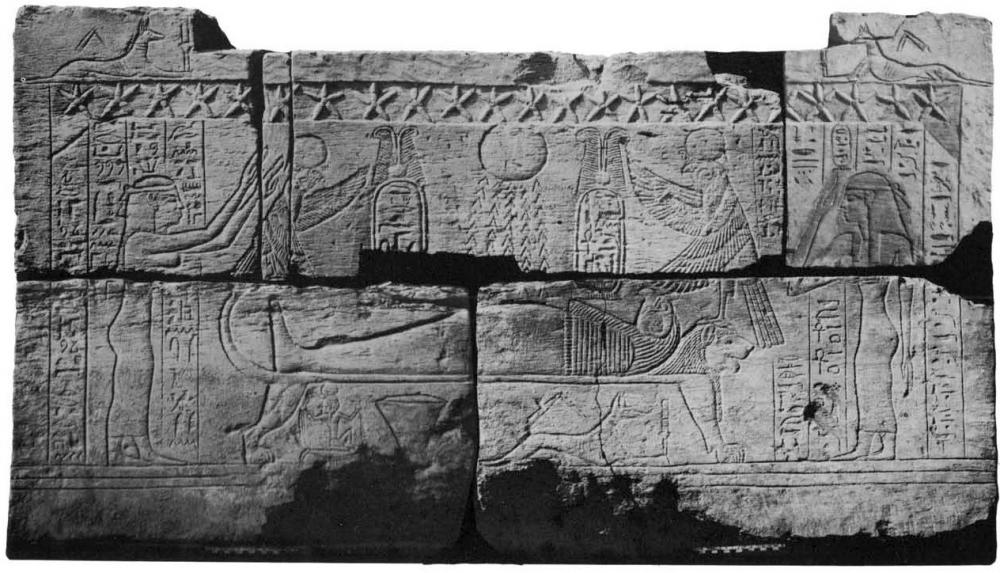
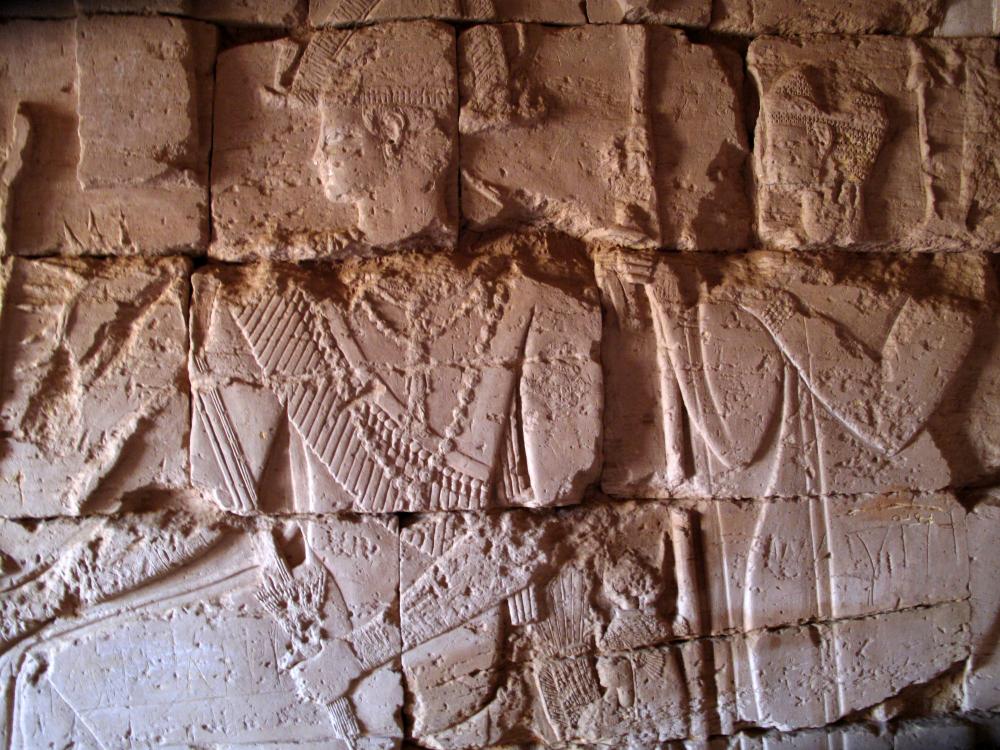
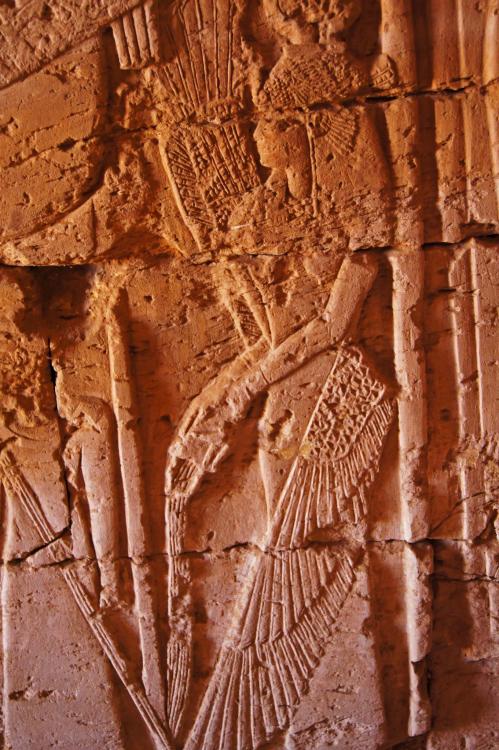
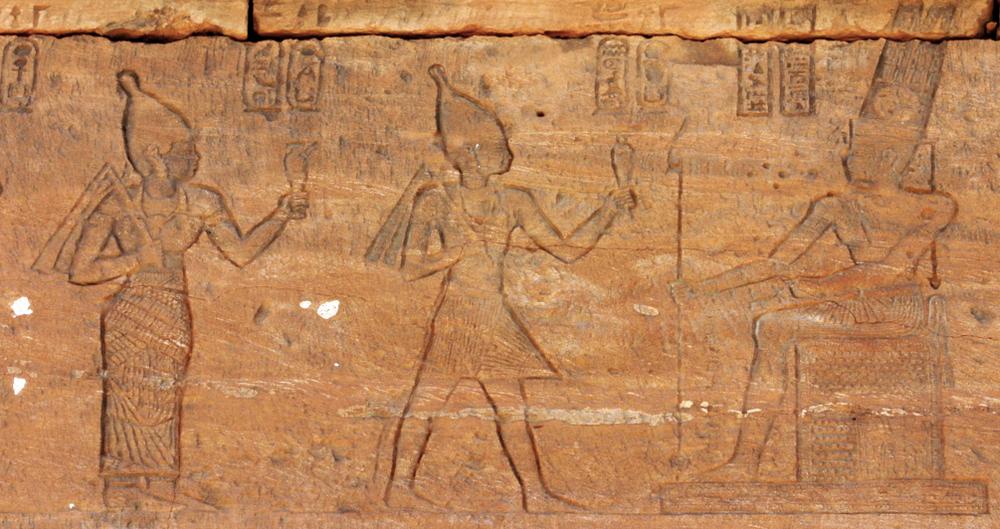
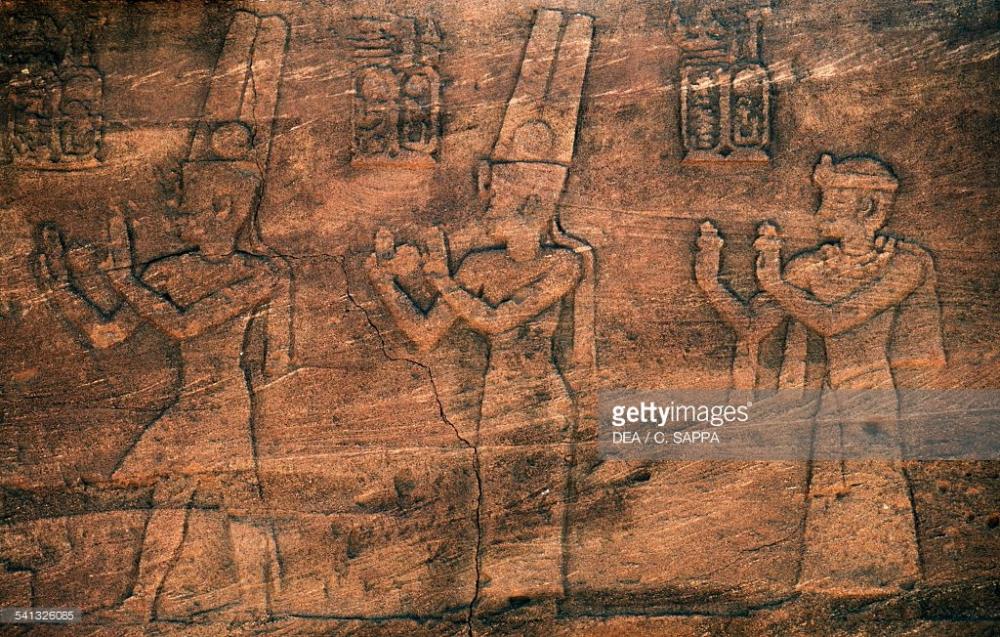
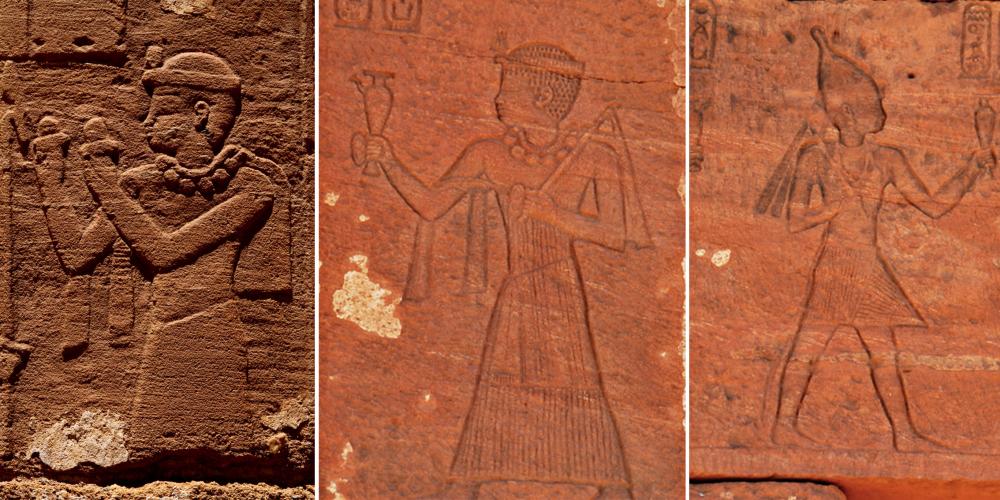
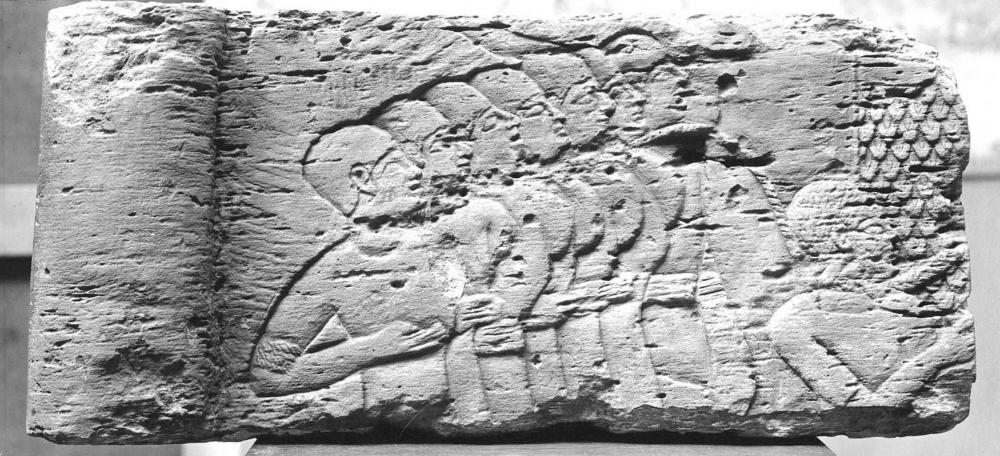
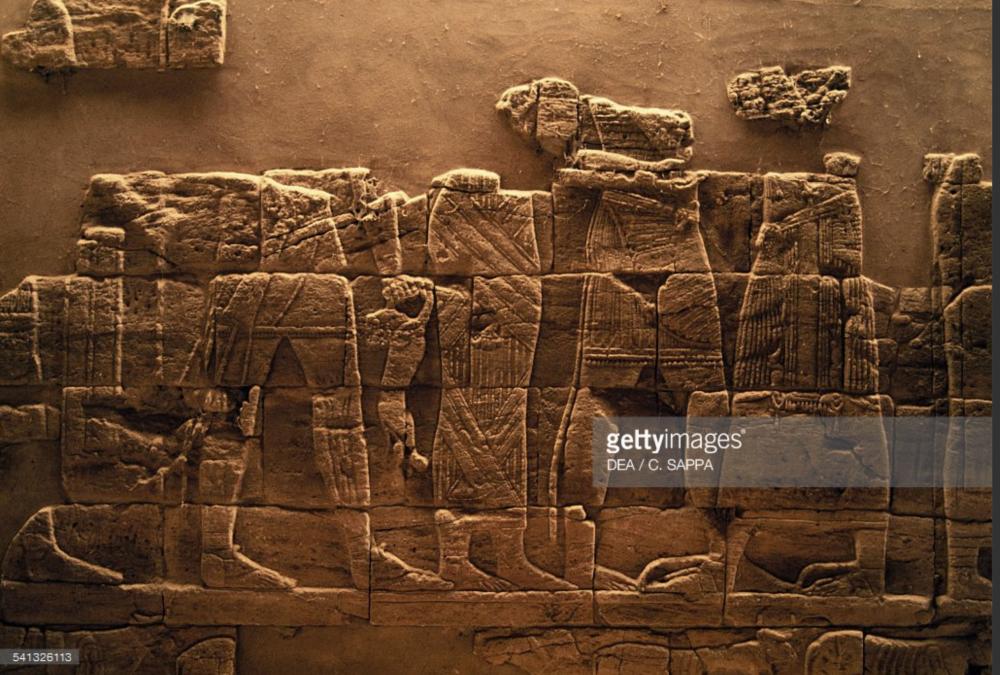
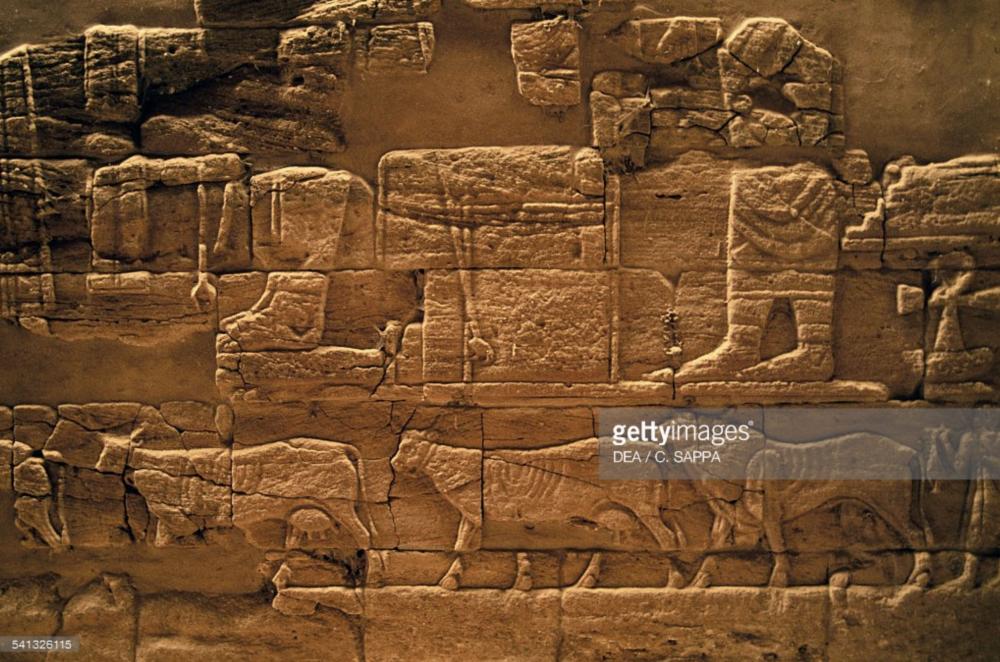
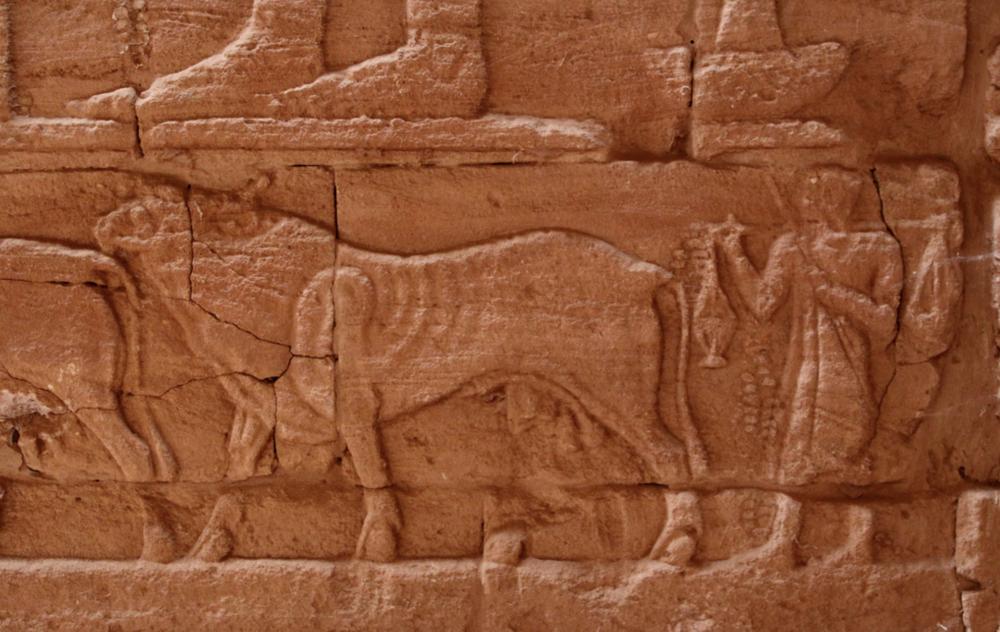
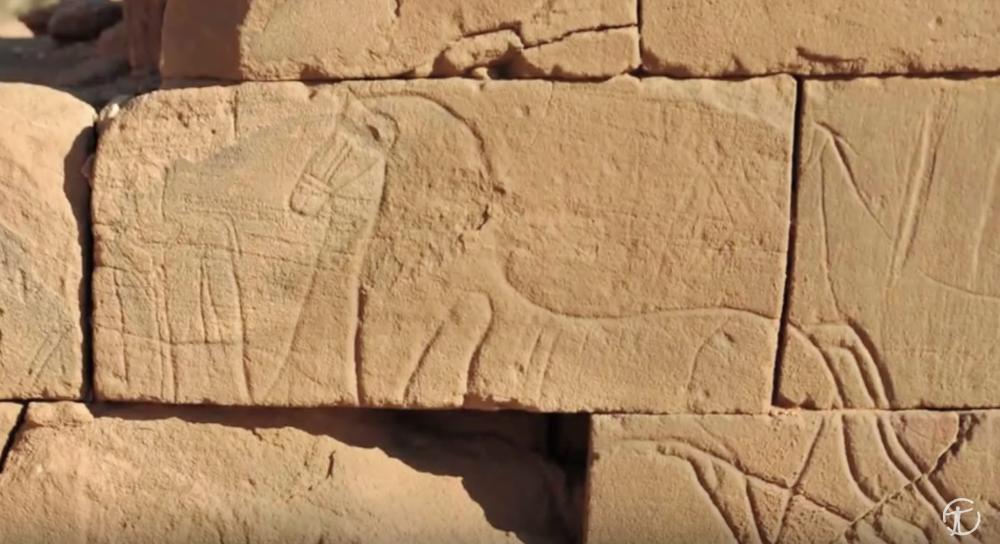
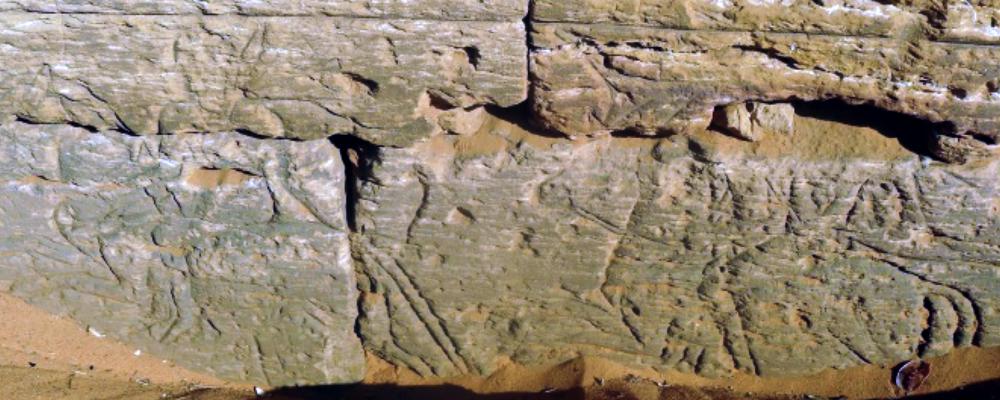
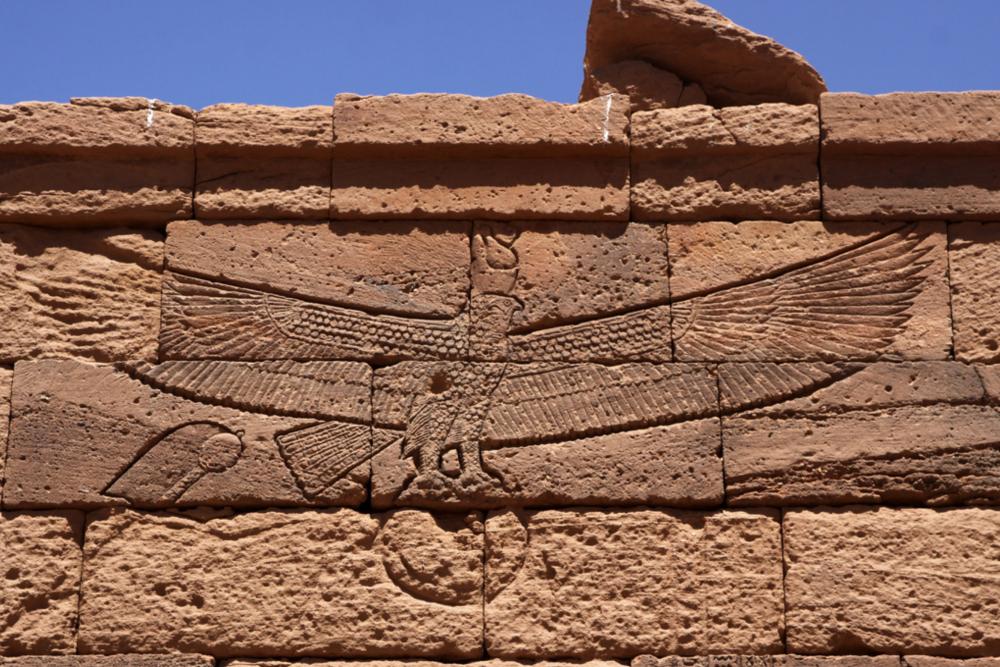
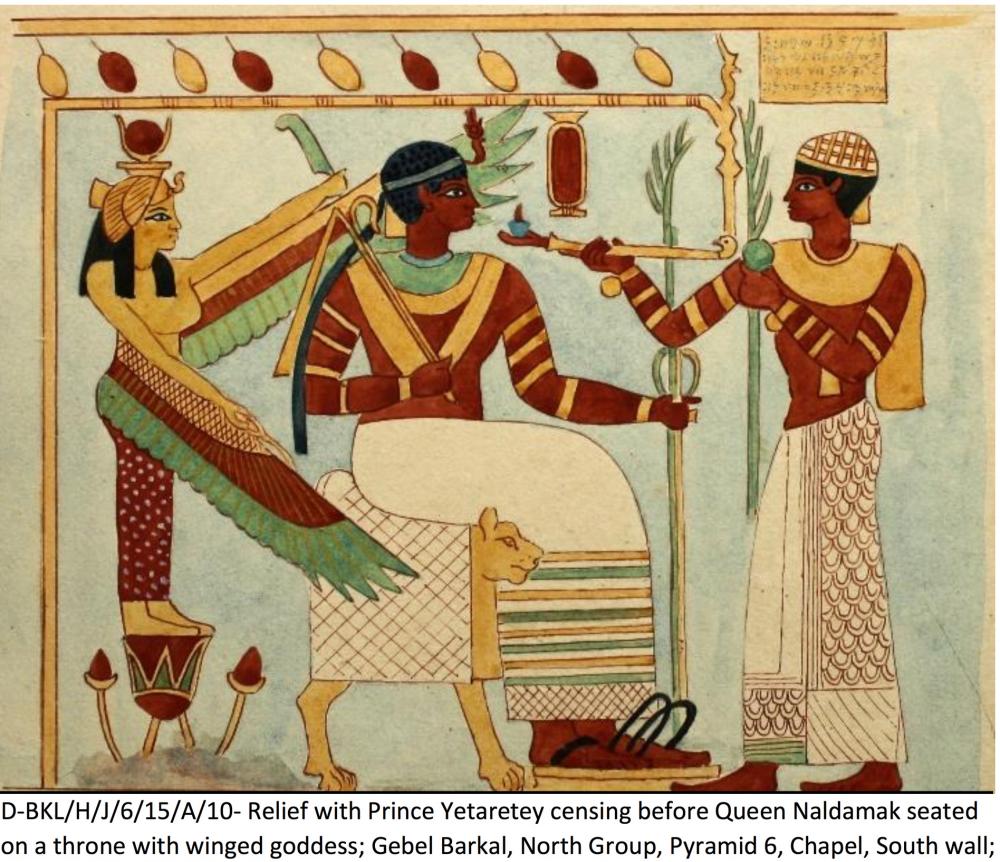
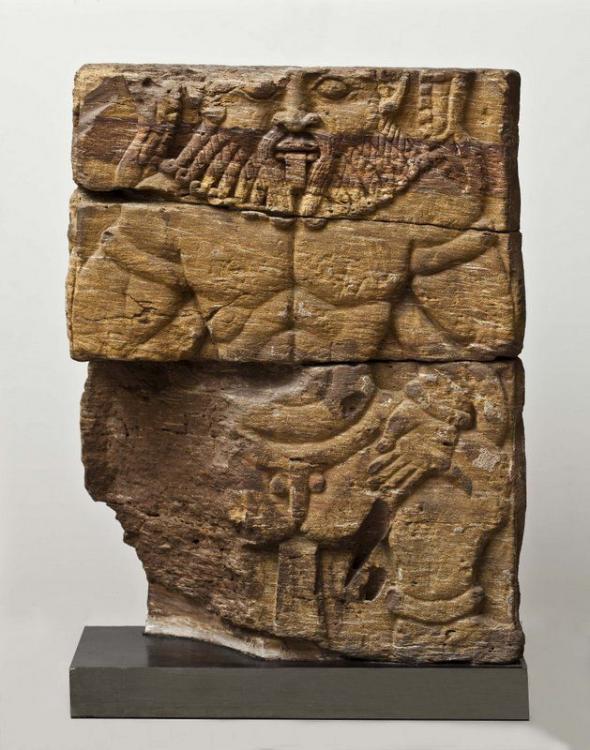
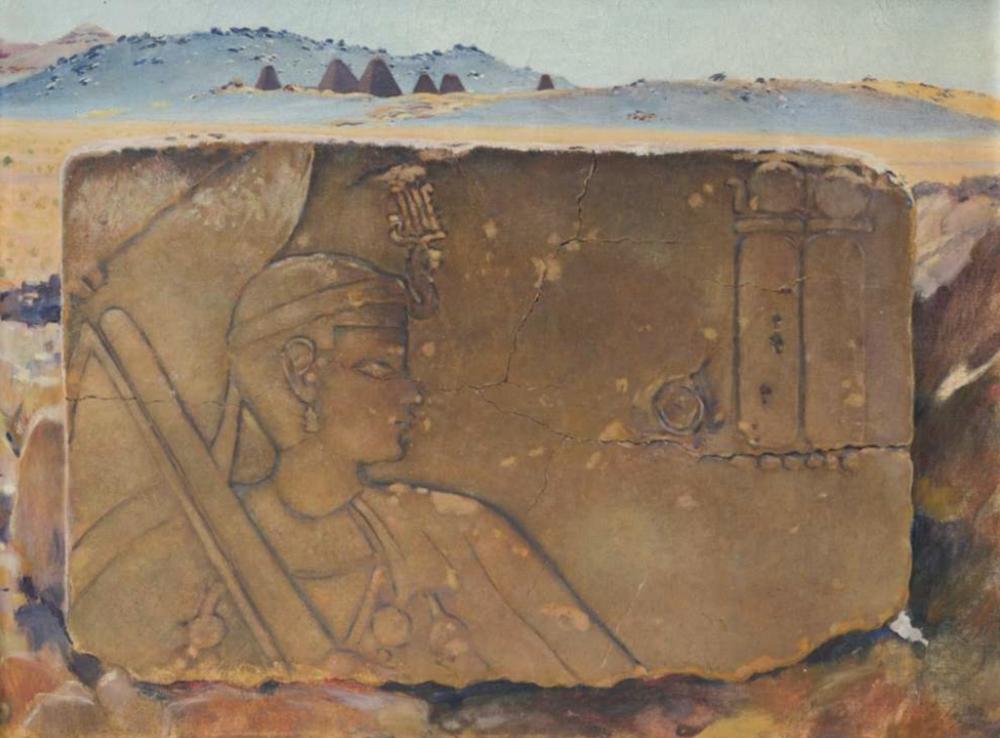
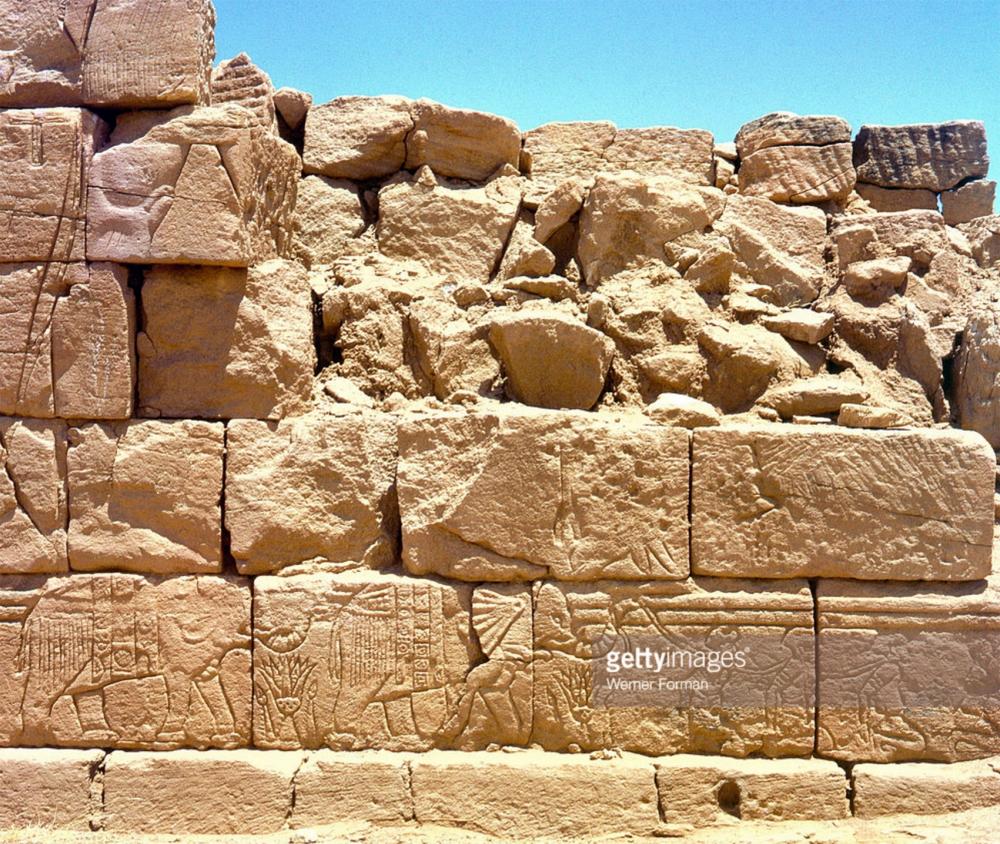
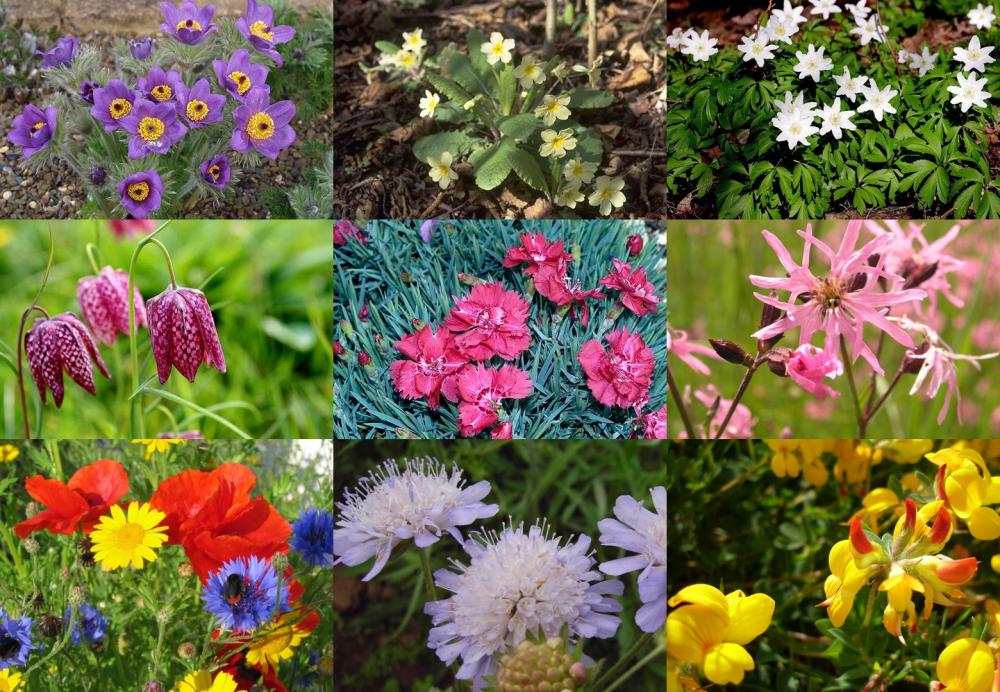
Your 0 A.D. Screenshots
in General Discussion
Posted
The Uraeus wouldn't be a bad choice in itself. The thing is that it's just as closely associated with ancient Egypt as it is with Kush. Anybody that is familiar with Kushites will immediately recognise the ram-headed form of Amun, which is much more specifically associated with Kush:
- Human headed Amun = Amun of Thebes or Amun of Karnak
- Ram-headed Amun = Amun of Napata
Second issue with the Uraeus is that it's vertically orientated, and the important parts, like it's head surmounted by the solar disk, would either be cut off on top, or the entire thing needs to be scaled down to fit in the visible part of the circle, which would make it awkwardly small. There'd be no filling to the left and right of the cobra either.
Egyptian Uraeus:
Kushite Uraei originally lining the rooftop of one of the kiosks at the temple complex at Jebel Barkal in Napata: